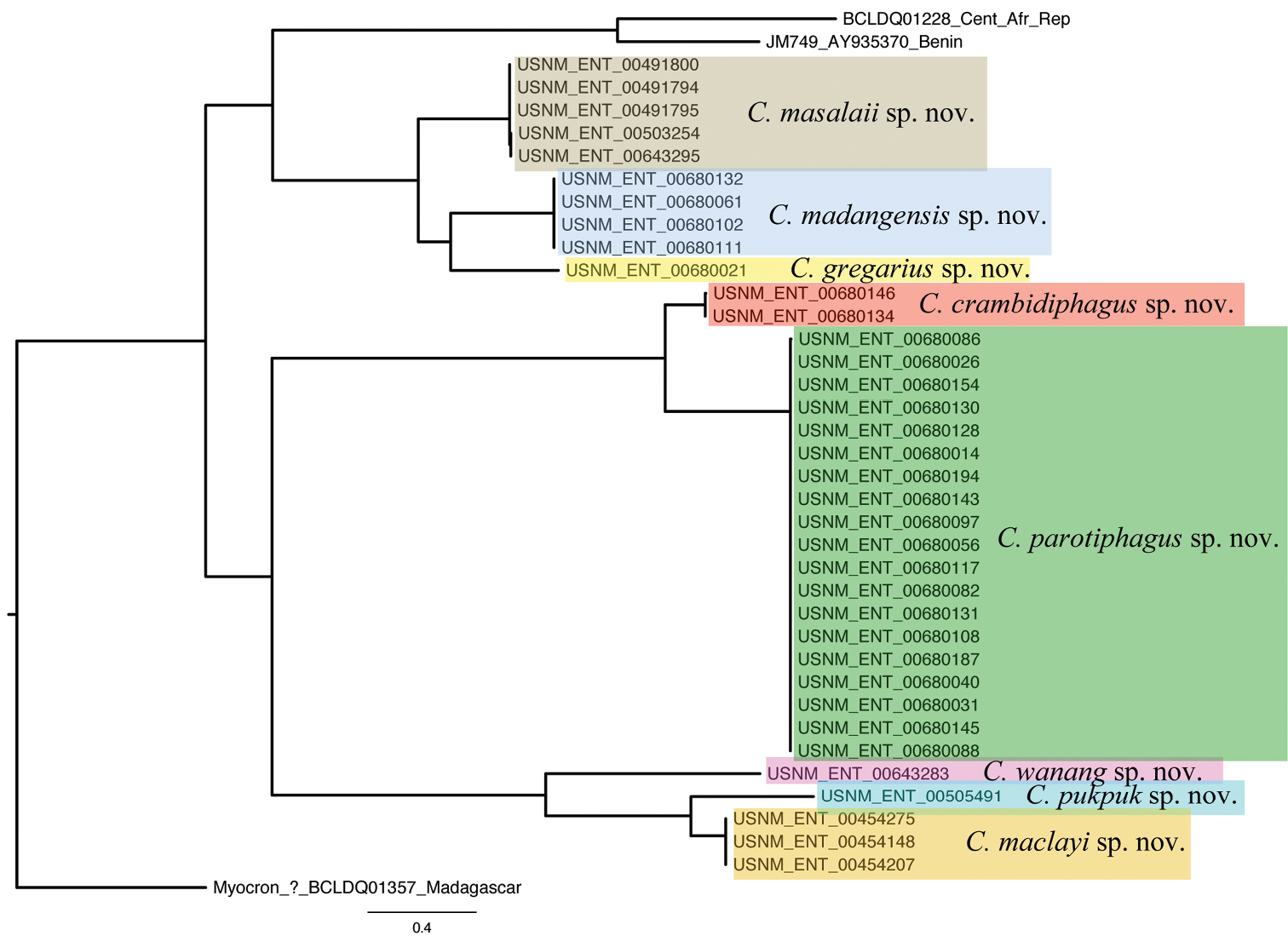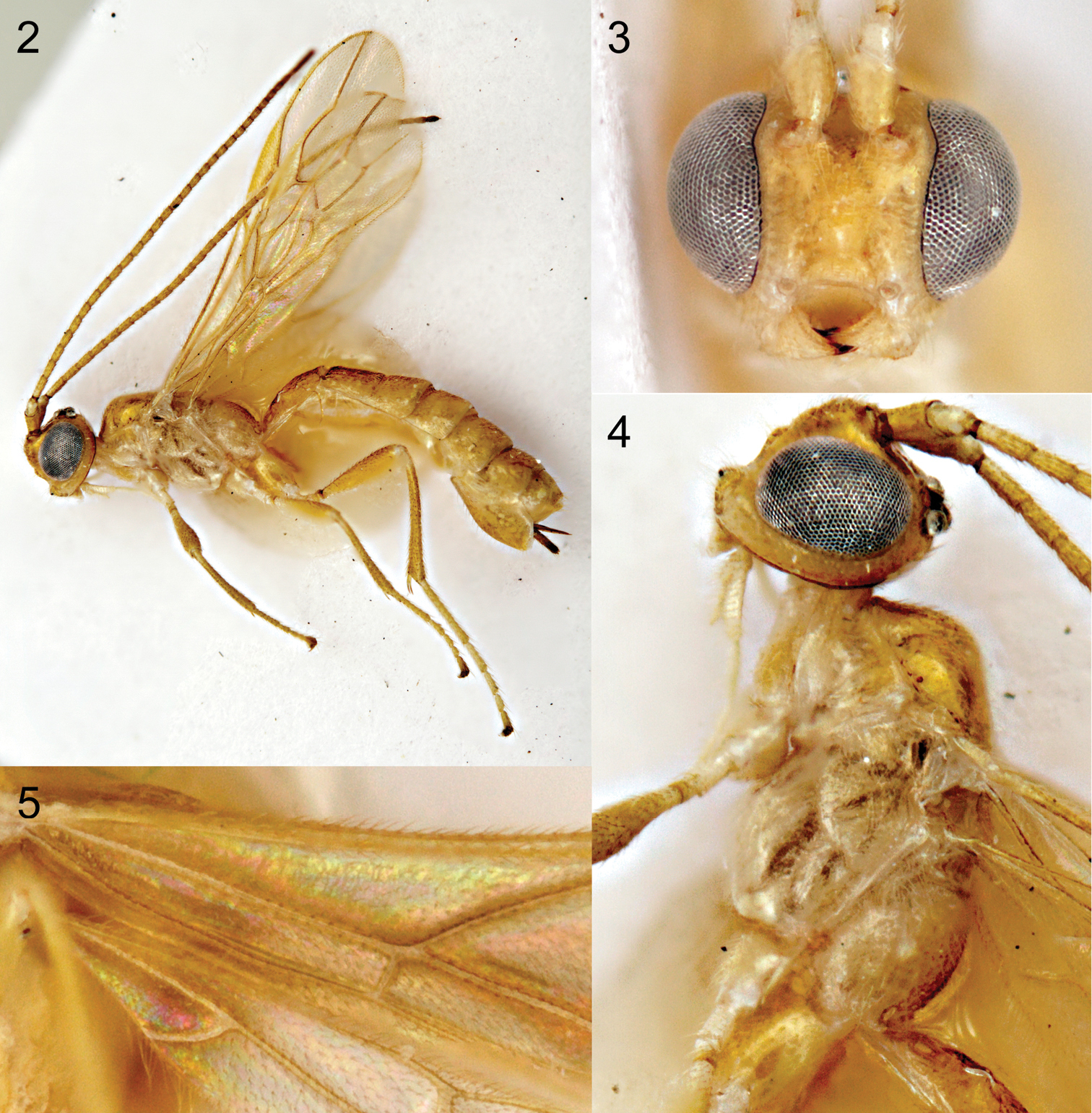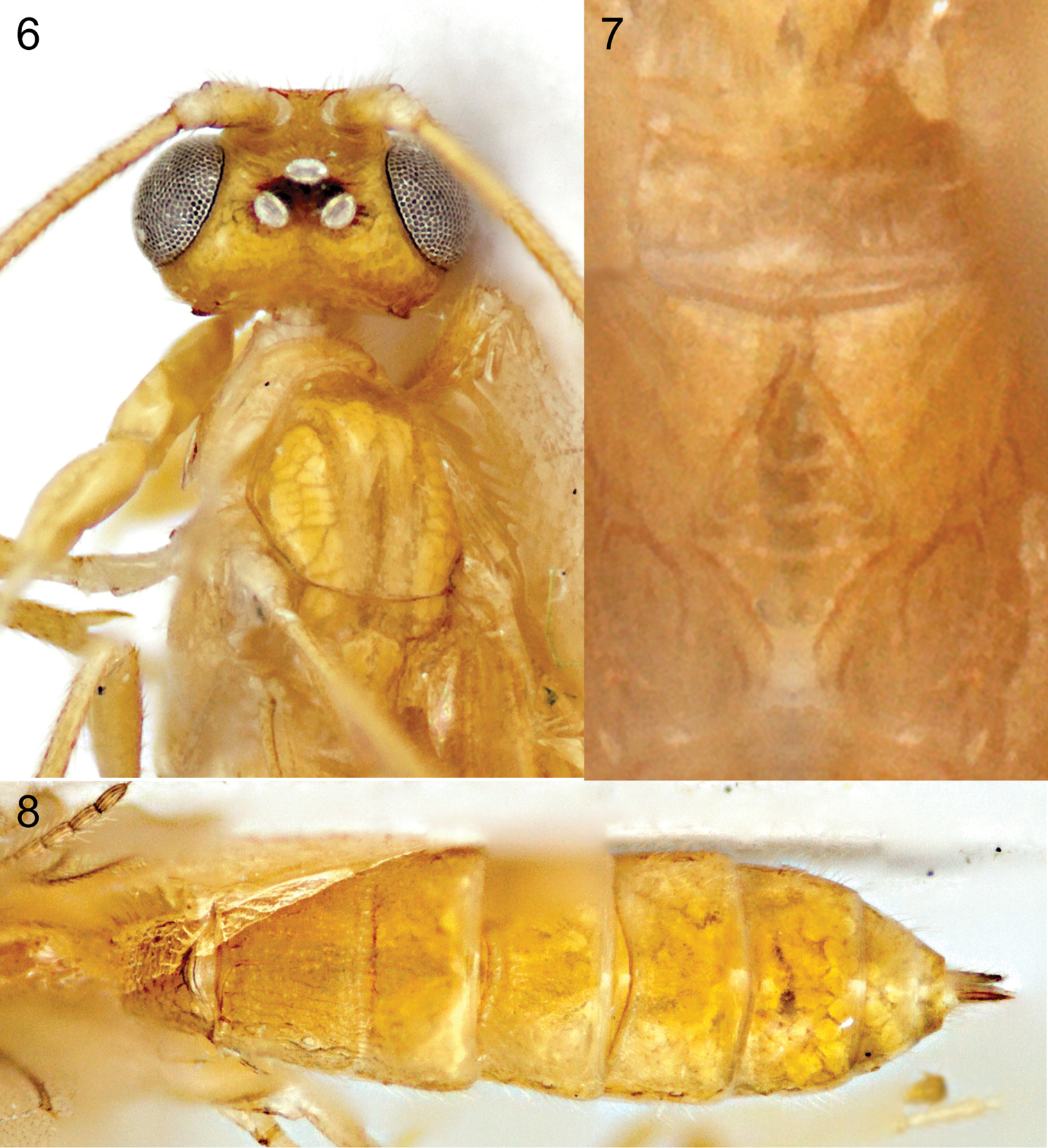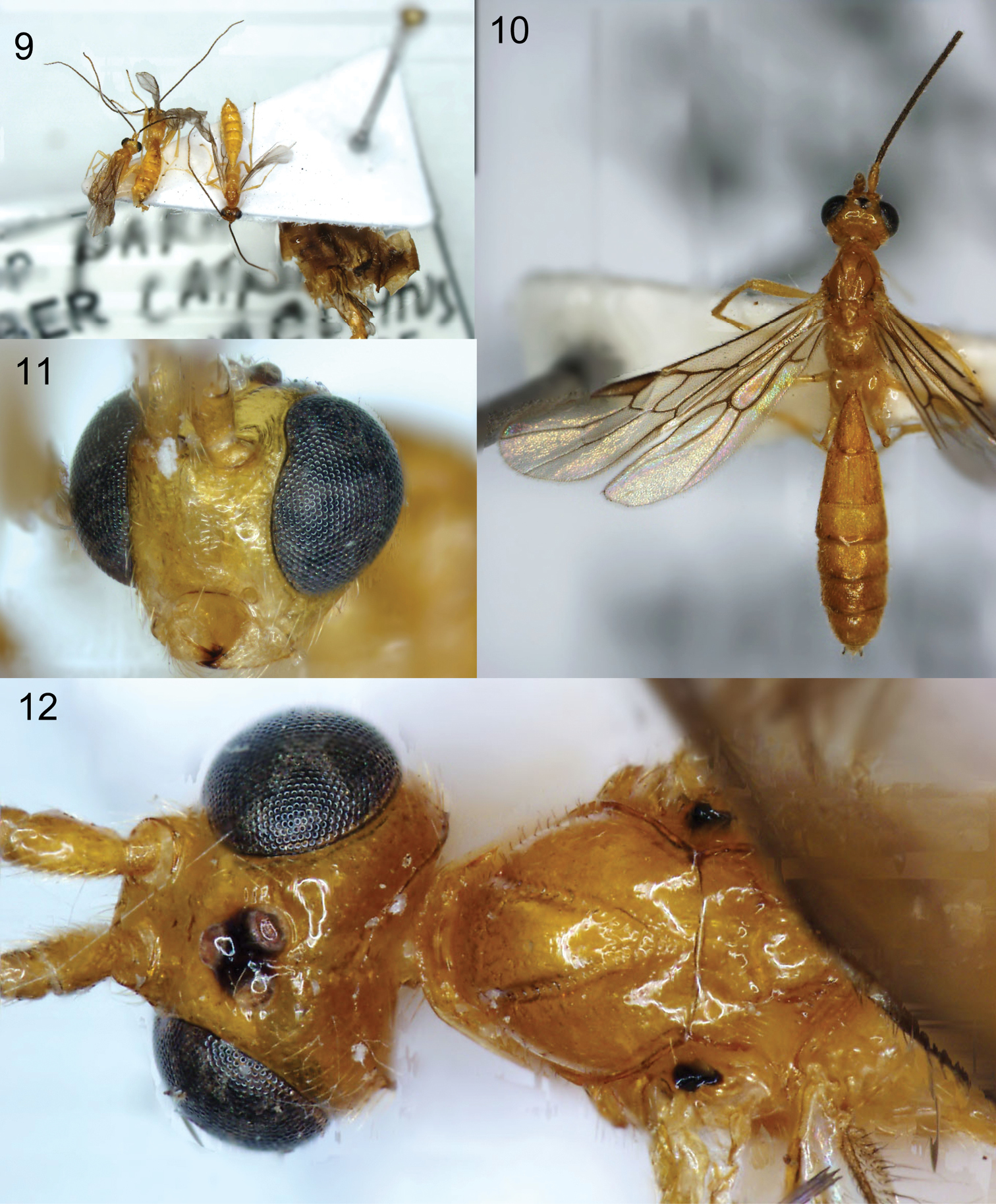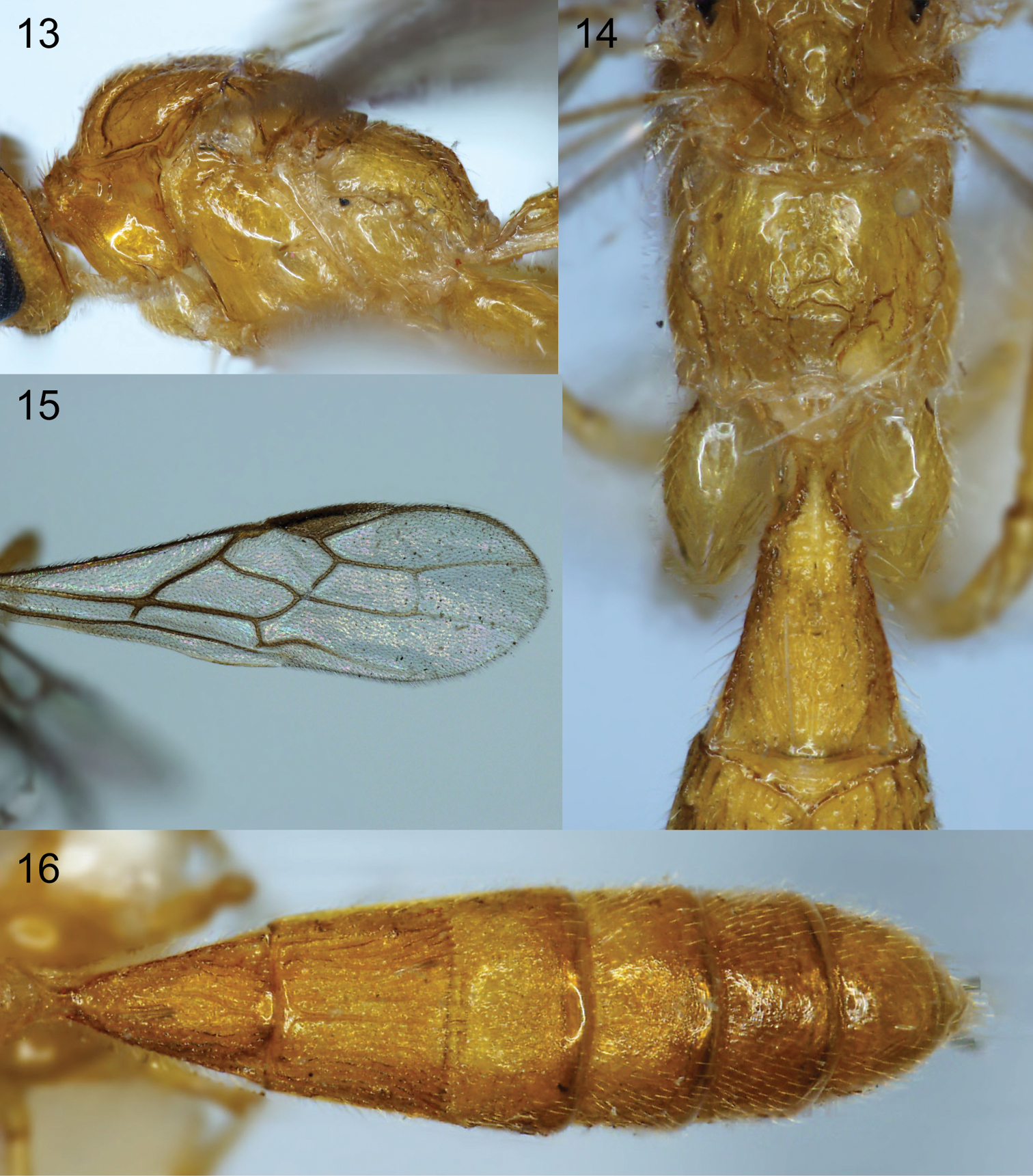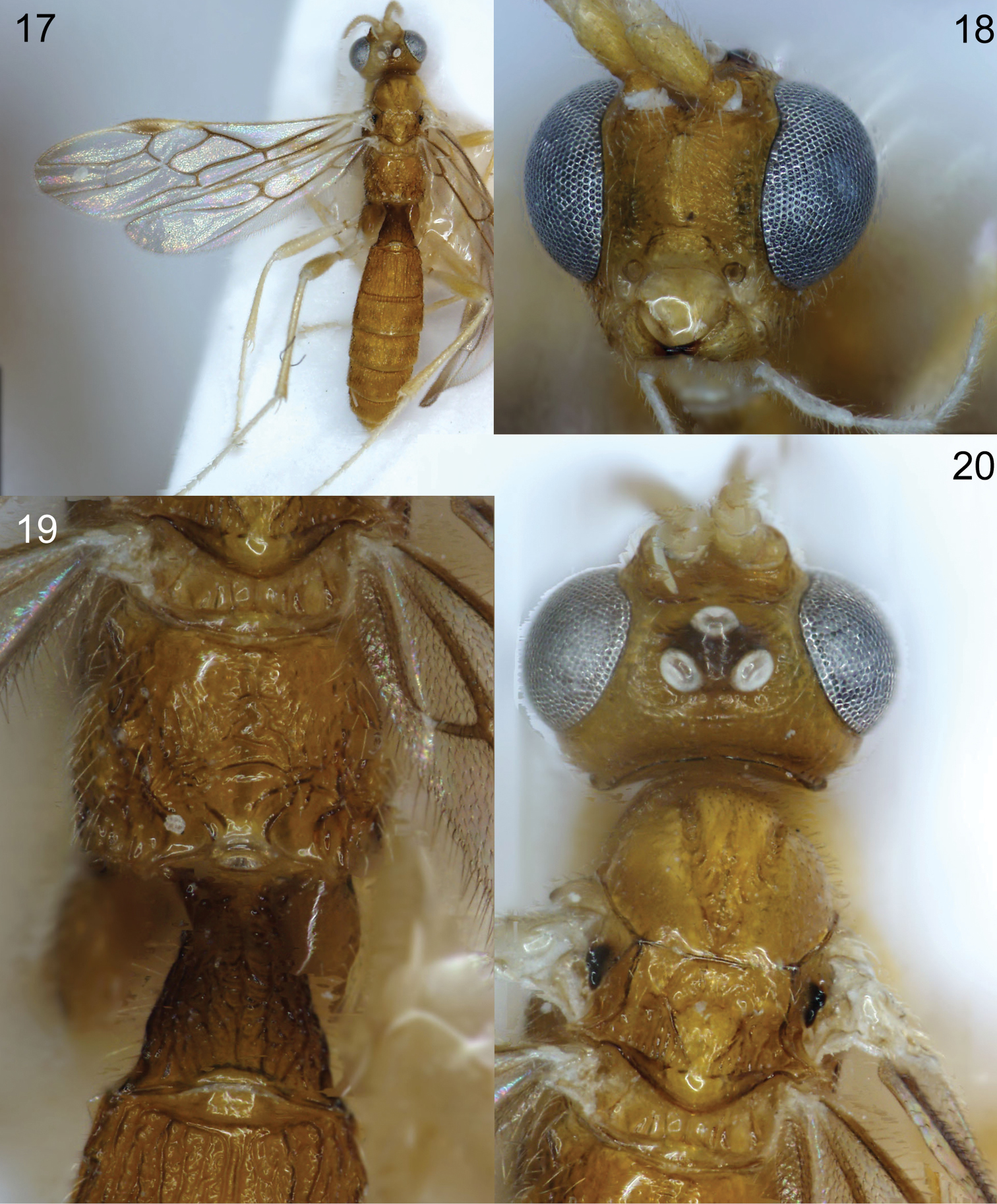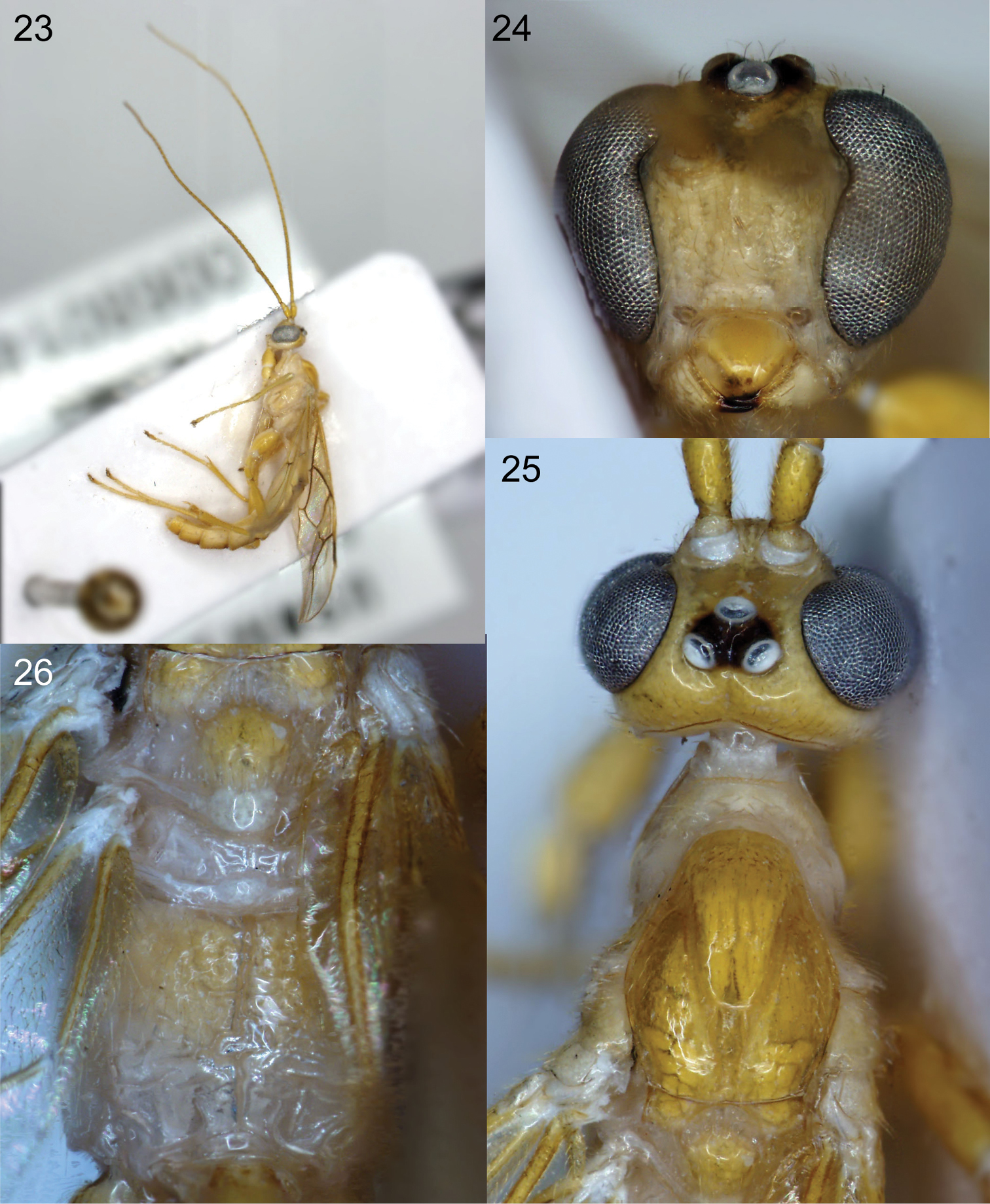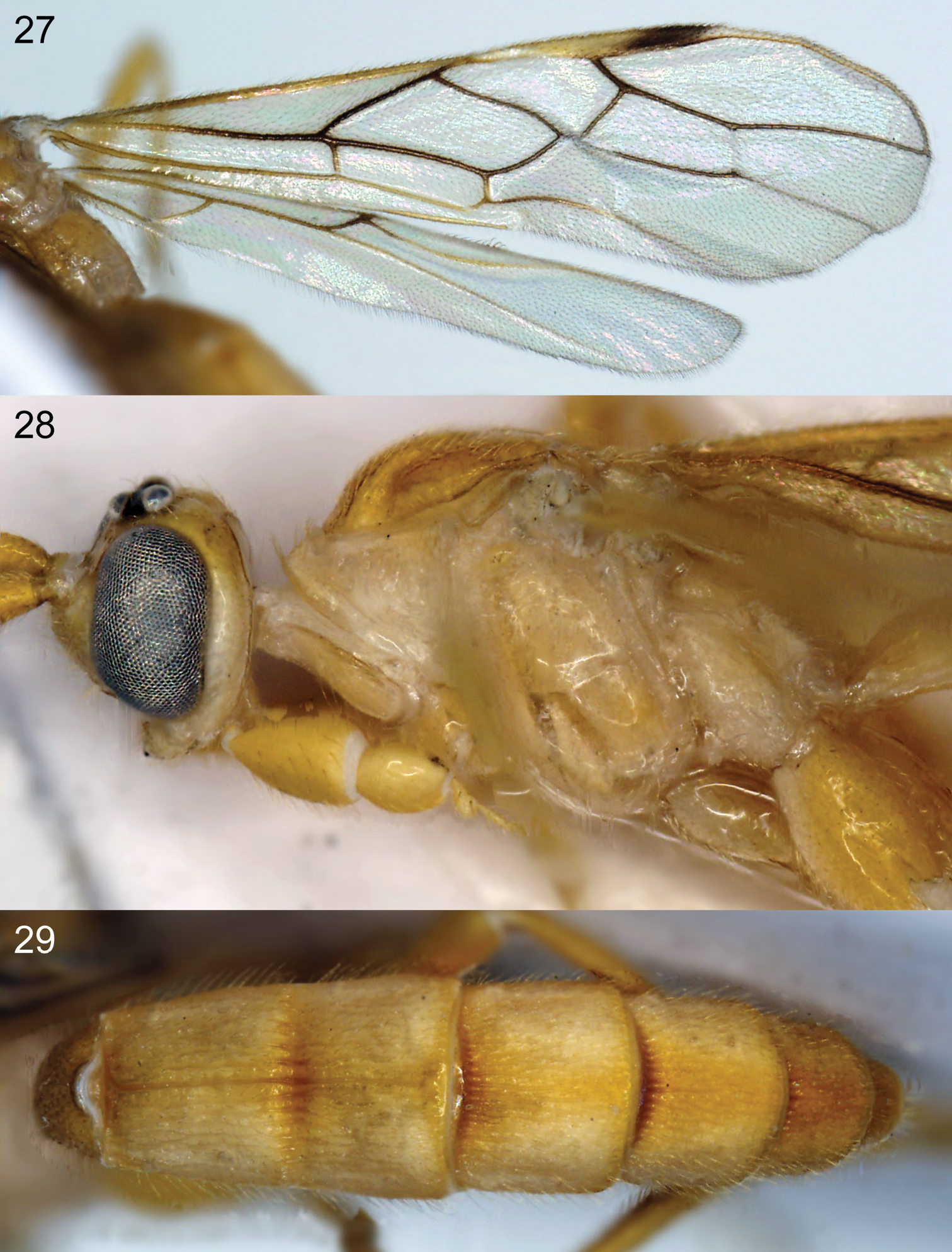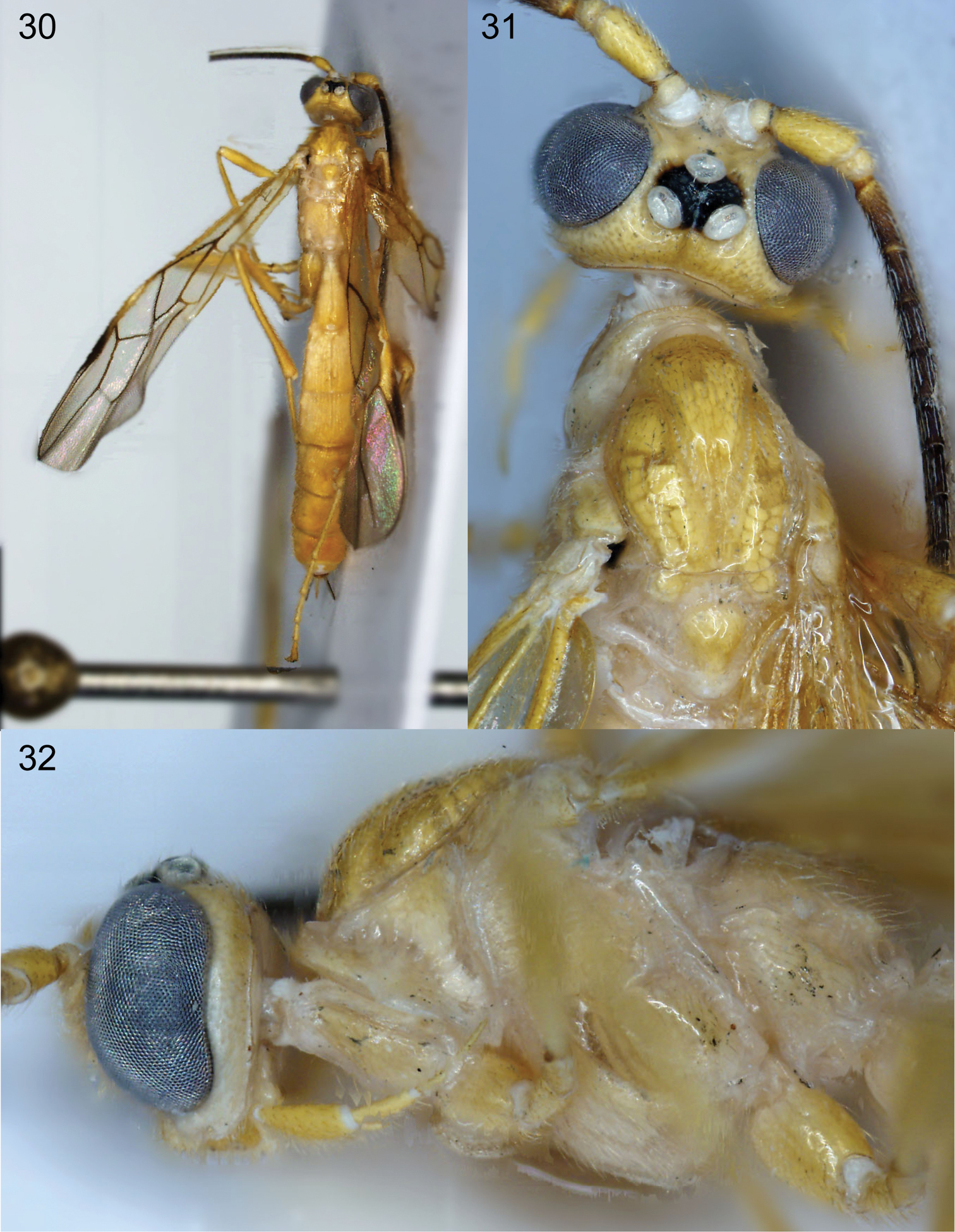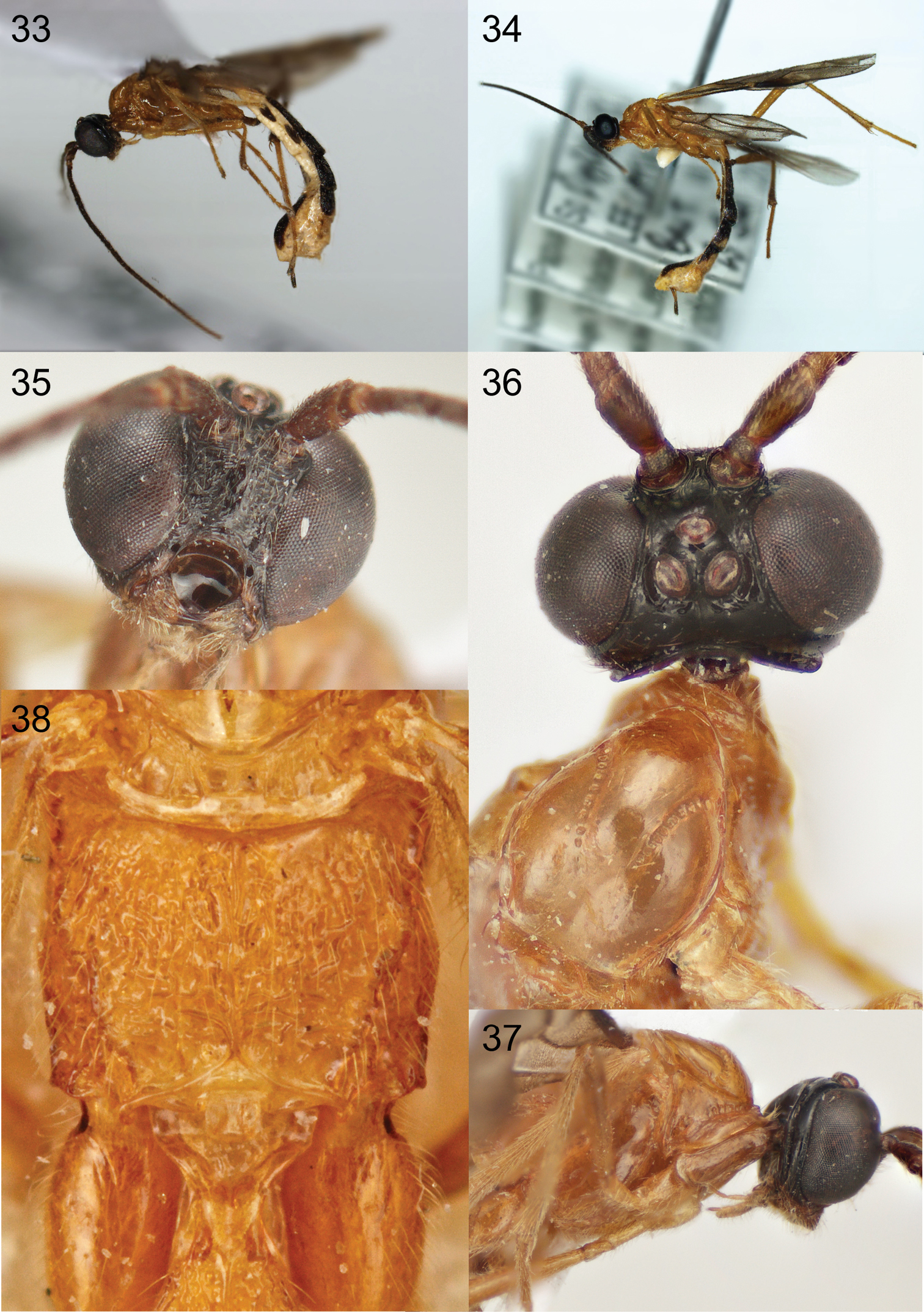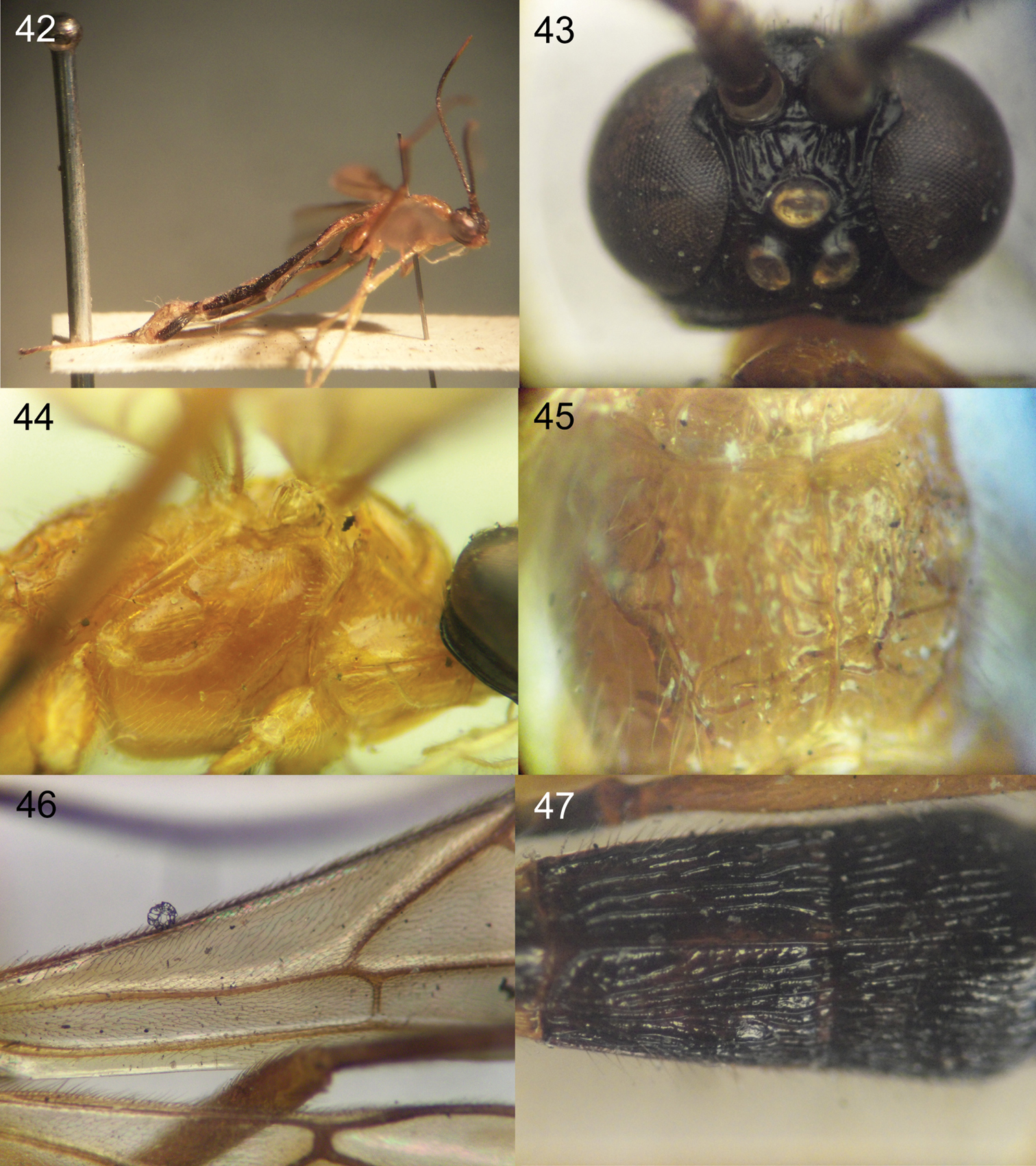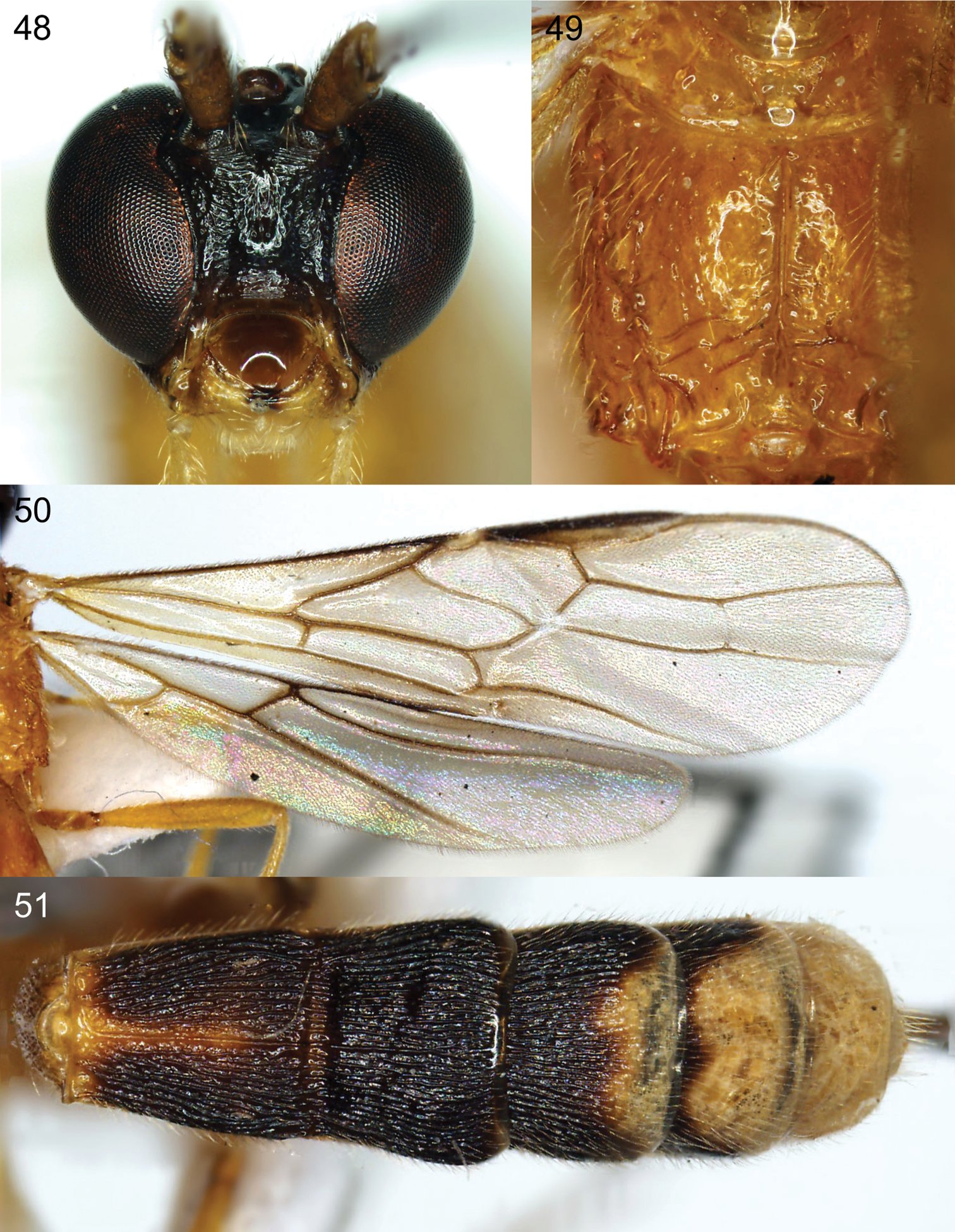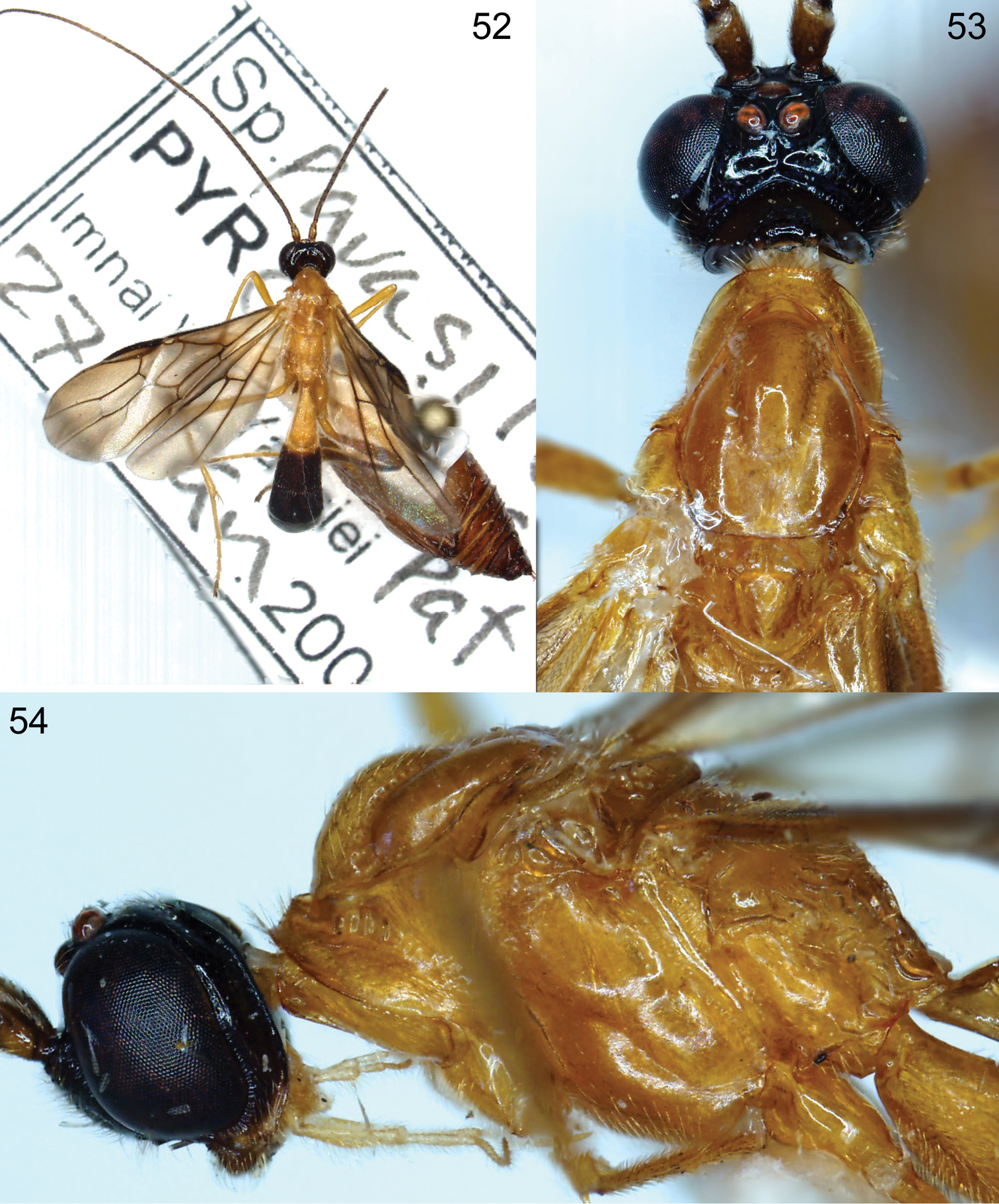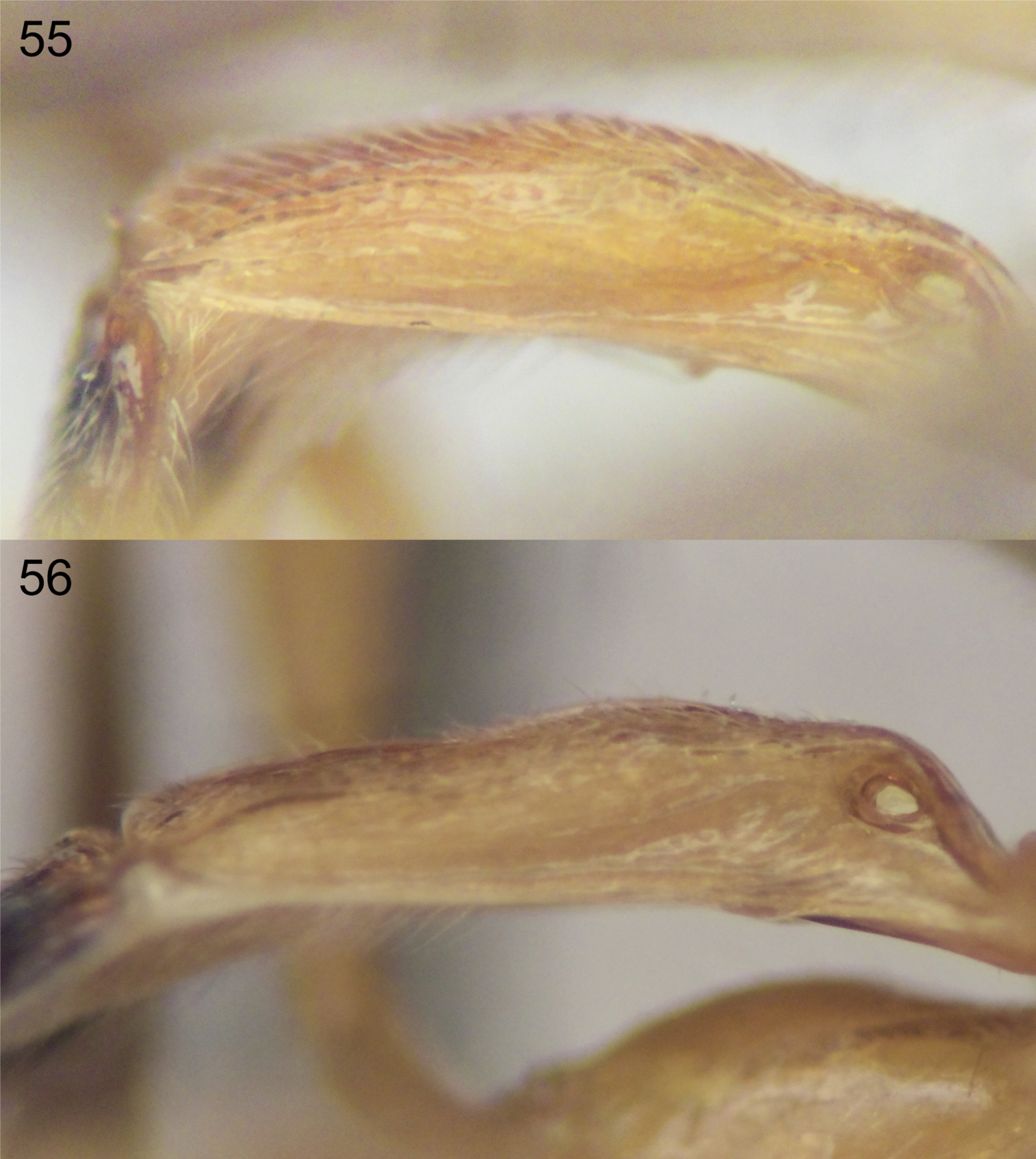






(C) 2012 Donald L.J. Quicke. This is an open access article distributed under the terms of the Creative Commons Attribution License 3.0 (CC-BY), which permits unrestricted use, distribution, and reproduction in any medium, provided the original author and source are credited.
For reference, use of the paginated PDF or printed version of this article is recommended.
Nine new species of Colastomion Baker are described, illustrated and keyed based on series of specimens reared from caterpillars of crambid moths from lowland Papua New Guinea plus one additional field collected specimen, viz. Colastomion cheesmanae Quicke sp. n., Colastomion crambidiphagus Quicke sp. n., Colastomion gregarius Quicke sp. n., Colastomion maclayi Quicke sp. n., Colastomion madangensis Quicke sp. n., Colastomion masalaii Quicke sp. n., Colastomion parotiphagus Quicke sp. n., Colastomion pukpuk Quicke sp. n. and Colastomion wanang Quicke sp. n. Most species are morphologically easily distinguished but DNA barcoding additionally reveals a pair of exceedingly similar species (Colastomion pukpuk sp. n. and Colastomion maclayi sp. n.) that might otherwise have gone unrecognised. The new species each appear to be relatively specialised on their host species and all parasitize only caterpillars of Lepidoptera: Crambidae: Spilomelinae.
cytochrome oxidase I, DNA barcoding, Lepidoptera, hosts, Rogadini, Crambidae
Colastomion
To date, only six species of Colastomion have been described, viz. Colastomion abdominale
Here we describe nine new species of Colastomion, eight of which are based on reared specimens from caterpillars feeding on various trees and shrubs in lowland Papua New Guinea. These were obtained during an extensive caterpillar collecting and rearing programme which has additionally yielded a number of other interesting rogadine parasitoids including the recently described, highly distinctive genus Vojtechirogas Quicke & van Achterberg (Quicke et al. 2012).
The host records for some of the species include a degree of fuzziness because identifications are based on caterpillar morphology. The actual parasitized caterpillars of course never produce an adult moth, and so there is always some degree of uncertainty with host records acquired by rearing. Because in the course of the New Guinea rearing programme there were several hundred thousand caterpillars reared, we are able to quantify the inevitable uncertainty. For any reared specimen we present only host records which are at least 95% sure, i.e. at least 95% of the tens or hundreds of moth adults reared from the same combination of caterpillar morphotype and host plant as the parasitoid agree with the reported host identification. Two rearing records for Colastomion masalaii sp. n. and Colastomion parotiphagus sp. n. were confirmed by sequencing host remnants (
The systematics of several of the moth taxa involved here, all of which belong to the crambid subfamily Spilomelinae, is also far from complete and there is no meaningful phylogeny as yet. Thus some genera may well be poly- or paraphyletic assemblages, and in these cases we have sometimes been able to assign hosts to species groups, that in the future may shift into other generic combinations.
TerminologyTerminology follows
Abbreviations: NHM (The Natural History Museum, London); USNM (United States National Museum, Washington D.C.). Note, some paratypes will be repatriated to PNG when analysis is complete.
MethodologyPhylogenetic inference and bar-coding discrimination of species were based upon maximum likelihood (ML) analysis of approximately 657 base pairs of the 5’ end of the mitochondrial cytochrome oxidase I gene, using the programme RAxML (
Most specimens were imaged using Cell^D® imaging facility. Colastomion gregarious sp. n. and Colastomion cheesmanae sp. n. were imaged using a Canon EOS 7D camera, Adobe Lightroom software and edited using Adobe Photoshop CS4.
ResultsDNA barcodes were generated from all but one of the species described below, the exception being a nearly 80 year old specimen found in the NHM collection. Fig. 1 shows a ML tree from these, with eight clearly separated molecular species, and intraspecific variation was limited to two individuals of Colastomion masalaii sp. n. (vouchers USNM ENT 00503254 and 00643295) differing from the remainder at a single base position.
Maximum likelihood tree (using GTR+G parameter model) of the reared and barcoded species of Colastomion (final Gamma –based likelihood -2578.386754).
| 1 | Fore wing vein cu-a antefurcal (Figs 5, 15, 21); propodeum with short midlongitudinal carina anteriorly, giving rise to a midlongitudinal depression with transverse crenulae or transverse rugosity (Fig. 7); antenna with fewer than 42 [31–39] flagellomeres (Fig. 2); hind wing vein M+CU shorter [0.6–0.9 ×] than 1-M; largely yellow or yellow brown, metasoma the same colour as mesosoma | 2 |
| – | Fore wing vein cu-a postfurcal; propodeum with a complete midlongitudinal carina or if incomplete, replaced by rugosity on posterior half; antenna with more than 43 [45–57]; flagellomeres; hind wing vein M+CU longer [1.1–2.5 ×] than 1-M; colour variable, sometimes metasoma black and cream contrasting with yellow-brown mesosoma | 4 |
| 2 | Antenna with fewer than 35 [32] flagellomeres (Fig. 2); 3rd segment of female maxillary palp distinctly swollen, approximately 4.5 × longer than maximally wide; pterostigma entirely pale yellow (Fig. 2); mesosoma brown yellow dorsally with posterior of pronotum, mesopleuron, mesosternum and metapleuron whitish (Fig. 4) | Colastomion gregarius sp. n. |
| – | Antenna with more than 35 [37–40] flagellomeres; 3rd segment of female maxillary palp slender, approximately 7 × longer than maximally wide; pterostigma either bicolorous (Fig. 21) or entirely dark grey (Fig. 15); mesosoma unicolorous, either entirely pale yellow or brown yellow (Fig. 13) | 3 |
| 3 | Pterostigma largely dark brown; antenna largely dark brown (Fig. 15); fore wing vein cu-a strongly inclivous (Fig. 15) | Colastomion masalaii sp. n. |
| – | Pterostigma bicolorous, cream on basal 0.3 and on anterior margin, remainder brown (Fig. 21); antenna cream coloured; fore wing vein cu-a vertical (Fig. 21) | Colastomion madangensis sp. n. |
| 4 | Metasoma almost entirely brown-yellow, sometimes with basal grooves of tergites brown medially (Figs 29, 30); 5th segment of female maxillary palp less than 0.6 [0.5 ×] 6th segment (Fig. 32) | 5 |
| – | Metasomal tergites 3–4 largely black (Figs 39, 47, 51, 52); 5th segment of female maxillary palp more than 0.6 [0.7–0.9 ×] 6th segment (Fig. 54) | 6 |
| 5 | Flagellum entirely yellow; metasomal tergites 3–5 pale yellow with distinctly brown yellow mark narrowly mediobasally, tergite 6 somewhat more extensively brown yellow medially (Fig. 29) | Colastomion crambidiphagus sp. n. |
| – | Flagellum black on basal half becoming paler, sometimes yellow, from about middle to shortly before tip, contrasting strongly with pale yellow scapus and pedicellus (Fig. 31); metasomal tergites more or less evenly coloured pale yellow (Fig. 30) | Colastomion parotiphagus sp. n. |
| 6 | Fore wing vein M+CU thickened up to near its middle and sharply narrowing and curved beyond this (Figs 41, 42) | Colastomion wanang sp. n. |
| – | Fore wing vein M+CU more or less evenly thick and straight or only weakly curved (Figs 46, 50, 52) | 7 |
| 7 | Anterior of propodeum strongly sculptured, rugose (Fig. 47, see also Fig. 38); 2nd subdiscal cell rather widened distally, maximum length of cell membrane < 3.5 [3.1] × maximum width (see Fig. 41) | Colastomion cheesmanae sp. n. |
| – | Anterior of propodeum on either side of midlongitudinal carina largely smooth with punctures or at most with narrow crenulated groove next to carina (Figs 49, 54); 2nd subdiscal cell long and narrow, maximum length of cell membrane < 3.7 [4.0] × maximum width (Fig. 50) | 8 |
| 8 | 1st tergite in lateral profile distinctly deeper near midlength (Fig. 55) | Colastomion pukpuk sp. n. |
| – | 1st tergite in lateral profile deepest on anterior third and behind this flat or weakly depressed (Fig. 56) | Colastomion maclayi sp. n. |
urn:lsid:zoobank.org:act:6C64E6C5-8CB9-48B3-9A92-1475E7779B24
http://species-id.net/wiki/Colastomion_gregarius
Figs 2–8Holotype female, Papua New Guinea, Madang Province, Wanang, 24-May-07, 145°10.910'E, 5°13.853'S, 100m, ex caterpillar on Ficus variegata Blume (Moraceae) (voucher USNM ENT 00680021; BOLD ASQSP084-08; Genbank JF963128) [furthest specimen from pin on topmost card] (USNM)
Paratypes. 4 males and 3 females, 1 unknown (missing metasoma), rest of reared series from the same parasitized host, mounted on total of 3 cards and on same pin as holotype. (USNM).
Length of body 4.0–4.8 mm, of fore wing 3.0–3.6 mm and of antenna 5.1–5.2 mm.
Head. Antenna with 31–32 flagellomeres. Terminal flagellomere acuminate. Median flagellomeres approximately 2 × longer than wide. 3rd segment of maxillary palp of female weakly swollen, approximately 4.5 longer than maximally wide. 5th segment approximately same length as 6th. Base of mandible well removed from eye, closest point approximately 1.3 distance from middle of anterior tentorial pit and eye. Distance between anterior tentorial pits approximately 2.7 × shortest distance between pit and eye. Width of face: width of head across eyes: height of eye = 1.0 : 2.25 : 1.3. Face rather shiny, with fine transverse striation laterally above level of clypeus. Shortest distance between posterior ocelli: transverse diameter of posterior ocellus: shortest distance between posterior ocellus and eye = 1.0: 1.2 : 1.4. Occipital carina broadly obliterated or extremely weak mediodorsally
Mesosoma. Notauli narrow, moderately impressed, crenulated. Mesoscutum longitudinally striate-rugulose at confluence of notauli. Mesopleuron largely smooth and shiny. Precoxal sulcus deeply impressed and strongly crenulate. Propodeum with very short midlongitudinal carina anteriorly that splits giving rise to pair of weak carinae bordering a widening midlongitudinal depression with moderately well developed transverse striation. Propodeum with distinct mediolateral projections.
Fore wing. Vein 1-CU1 antefurcal. Vein 2-CU1 6.0 × longer than 1-CU1. Vein 1-M weakly curved. Lengths of veins SR1: 3-SR: r = 6.0: 2.7 : 1.0. Vein 2-SR 1.0 × 2-SR+M.
Hind wing. Vein M+CU 0.9 × length of 1-M. Vein 2-SC+R thickened and distinctly inclivous. Vein SR moderately strongly curved on basal half, almost reaching wing margin approximately half distance to wing tip, then running more or less parallel to wing margin.
Metasoma. 1st metasomal tergite 1.7 × longer than posteriorly wide. 2nd metasomal tergite 1.6 × wider than long, with wide midbasal triangular area giving rise to weak midlongitudinal carina; rather weakly irregularly longitudinally striate with approximately 7 striate lateral to midlongitudinal carina. 3rd metasomal tergite 1.9 × wider than long; weakly irregularly longitudinally rugulose-striate basally and medially. 4th - 6th tergite s smooth.
Colastomion gregarius sp. n. light photomicrographs. 2 Habitus, lateral view 3 face 4 head and mesosoma, lateral view 5 basal venation of fore wing.
Colastomion gregarius sp. n. light photomicrographs. 6 Head and anterior mesosoma, dorsal view 7 propodeum 8 metasoma.
Body, legs, wing venation and antennae largely pale ochreous yellow with malar region, posteroventral part of pronotum, propleuron, mesopleuron and mesosternum, metapleuron, sides of tergites 2–6 and fore and mid coxa, trochanter and trochantellus whitish; terminal 6 or 7 flagellomeres dark grey-black.
Gregarious parasitoid of Glyphodes near stolalis.
Based on gregarious biology.
urn:lsid:zoobank.org:act:0C6B94FD-975C-435A-A554-171939C4D138
http://species-id.net/wiki/Colastomion_masalaii
Figs 9–16Holotype female, East Sepik Province, Wamangu, 143°39.125’E, 03° 47.228'S, 100m, 30-Mar-05, ex caterpillar on Ficus bernaysii King (Moraceae), . (voucher USNM ENT 00503254; BOLD ASQSP055-08; Genbank JF271305) [furthest individual from pin on card]. Host remnants were sequenced (BOLD ASPN766-09, Genbank JF271356) and the sequence identified as Glyphodes margaritaria.
Paratypes. 2 additional females on same card and from same brood as holotype; see Table 1 for all data on 30 additional rearings totalling 33 paratypes. Specimens USNM ENT 00491800, USNM ENT 00491811 and USNM ENT 00648414 are deposited in the BMNH.
Collection data, sex, host and host plant associations of paratypes of Colastomion masalaii sp. n.
| USNM ENT voucher number | BOLD process ID | Genbank accession number | No. and sex | Province | Localitya | Latitude and longitude | Collection date | Host identification | Host plant |
|---|---|---|---|---|---|---|---|---|---|
| 00209066 | - | - | 4F | Madang | Baitabag | 145°47'E, 5°08'S | 20-Nov-02 | Crambidae | Ficus molior F. Meull. ex Benth. (Moraceae) |
| 00211702 | - | - | 1F | East Sepik | Elem | 143°55'E, 4°49'S | 16-Apr-03 | Crambidae | Ficus conocephalifolia Ridley (Moraceae) |
| 00491773 | - | - | 1M | Sandaun | Utai | 141°35.153'E, 3°23.043'S | 28-Jul-04 | Crambidae | — ditto — |
| 00491774 | - | - | 1F | Sandaun | Utai | 141°35.153'E, 3°23.043'S | 28-Jul-04 | Crambidae | — ditto — |
| 00491775 | - | - | 1F | Sandaun | Utai | 141°35.153'E, 3°23.043'S | 28-Jul-04 | Crambidae | — ditto — |
| 00491776 | - | - | 1F | Sandaun | Utai | 141°35.153'E, 3°23.043'S | 28-Jul-04 | Crambidae | — ditto — |
| 00491790 | - | - | 1F | Sandaun | Utai | 141°35.153'E, 3°23.043'S | 28-Jul-04 | Crambidae | — ditto — |
| 00491794 | ASQSP126-08 | JF271307 | 1F | Sandaun | Utai | 141°35.153'E, 3°23.043'S | 28-Jul-04 | Crambidae | — ditto — |
| 00491795 | ASQSP125-08 | JF271308 | 1M | Sandaun | Utai | 141°35.153'E, 3°23.043'S | 28-Jul-04 | Crambidae | — ditto — |
| 00491799 | - | - | 1F | Sandaun | Utai | 141°35.153'E, 3°23.043'S | 28-Jul-04 | Crambidae | — ditto — |
| 00491800 | ASQSP128-08 | JF271306 | 1F | Sandaun | Utai | 141°35.153'E, 3°23.043'S | 28-Jul-04 | Crambidae | — ditto — |
| 00491801 | - | - | 1F | Sandaun | Utai | 141°35.153'E, 3°23.043'S | 30-Jul-04 | Talanga sexpunctalis complex | — ditto — |
| 00491807 | - | - | 1F | Sandaun | Utai | 141°35.153'E, 3°23.043'S | 28-Jul-04 | no host information | — ditto — |
| 00491808 | - | - | 1F | Sandaun | Utai | 141°35.153'E, 3°23.043'S | 28-Jul-04 | Crambidae | — ditto — |
| 00491809 | - | - | 1F | Sandaun | Utai | 141°35.153'E, 3°23.043'S | 28-Jul-04 | Crambidae | — ditto — |
| 00491810 | - | - | 1F | Sandaun | Utai | 141°35.153'E, 3°23.043'S | 28-Jul-04 | Crambidae | — ditto — |
| 00491811 | - | - | 1F | Sandaun | Utai | 141°35.153'E, 3°23.043'S | 28-Jul-04 | Crambidae | — ditto — |
| 00506254 | - | - | 4F | Madang | Ohu | 145°41'E, 5°14'S | 12-Jul-04 | Glyphodes margaritaria (Cramer) | Ficus dammaropsis Diels |
| 00643279 | - | - | 1F | Madang | Wanang | 145°10.910'E, 5°13.853'S | 26-Apr-05 | Crambidae | Ficus conocephalifolia Ridley |
| 00643281 | - | - | 1F | Madang | Wanang | 145°10.910'E, 5°13.853'S | 26-Apr-05 | Crambidae | — ditto — |
| 00643282 | - | - | 1F | Madang | Wanang | 145°10.910'E, 5°13.853'S | 26-Apr-05 | Crambidae | — ditto — |
| 00643285 | - | - | 1F | Madang | Wanang | 145°10.910'E, 5°13.853'S | 26-Apr-05 | Crambidae | — ditto — |
| 00643293 | - | - | 1F | Madang | Wanang | 145°10.910'E, 5°13.853'S | 26-Apr-05 | Crambidae | — ditto — |
| 00643294 | - | - | 1F | Madang | Wanang | 145°10.910'E, 5°13.853'S | 26-Apr-05 | Crambidae | — ditto — |
| 00643295 | ASQSP059-08 | JF271309 | 1M | Madang | Wanang | 145°10.910'E, 5°13.853'S | 26-Apr-05 | Crambidae | — ditto — |
| 00643298 | - | - | 1F | Madang | Wanang | 145°10.910'E, 5°13.853'S | 26-Apr-05 | Crambidae | — ditto — |
| 00643299 | - | - | 1F | Madang | Wanang | 145°10.910'E, 5°13.853'S | 26-Apr-05 | Crambidae | — ditto — |
| 00648414 | - | - | 1F | Madang | Wanang | 145°10.910'E, 5°13.853'S | 26-Apr-05 | Crambidae | — ditto — |
| 00648415 | - | - | 1F | Madang | Wanang | 145°10.910'E, 5°13.853'S | 26-Apr-05 | Crambidae | — ditto — |
| 00648419 | - | - | 1F | Madang | Wanang | 145°10.910'E, 5°13.853'S | 26-Apr-05 | Crambidae | — ditto — |
a Ohu is 200 m above mean sea level, other localities are 100 m above mean sea level
Length of body 5.5–6.5 mm, of fore wing 48–5.0 mm and of antenna 7.0 mm.
Head. Antenna with 35–37 flagellomeres. Terminal flagellomere pointed, not or hardly acuminate. Median flagellomeres 1.8 × longer laterally than wide. 3rd segment of maxillary palp of female not swollen, approximately 7 × longer than maximally wide. 5th segment approximately 0.7 length of 6th. Base of mandible well separated from eye, closest point approximately 1.2 distance from middle of anterior tentorial pit and eye. Distance between anterior tentorial pits approximately 3.0 × shortest distance between pit and eye. Width of face: width of head across eyes: height of eye = 1.0 : 2.3 : 1.3. Face with distinct transverse striation laterally. Frons with distinct pattern of elongate pits forming chevrons on either side of midlongitudinal sulcus. Shortest distance between posterior ocelli: transverse diameter of posterior ocellus: shortest distance between posterior ocellus and eye = 1.0: 1.6: 2.0. Occipital carina complete but irregular and weak mediodorsally
Mesosoma. Notauli more or less impressed along whole length, and crenulated, converging medioposteriorly and mesoscutum with some irregular rugosity at their confluence. Mesopleuron smooth and shiny. Precoxal sulcus strongly impressed, rather narrow, foveate. Propodeum with short midlongitudinal carina anteriorly that splits giving rise to a widening midlongitudinal depression with moderately well developed transverse striation. Propodeum with distinct mediolateral projections.
Fore wing. Vein 1-CU1 antefurcal. Vein 2-CU1 9 × longer than 1-CU1. Lengths of veins SR1: 3-SR: r = 5.5: 3.5: 1.0. Vein 2-SR 2.4 × 2-SR+M.
Hind wing. Vein M+CU 0.7 × length of 1-M.
Metasoma. 1st metasomal tergite 1.6–1.9 × longer than posteriorly wide. 2nd metasomal tergite 1.25 × wider than long, with well developed midbasal triangular area giving rise to weak midlongitudinal carina; irregularly longitudinally striate with approximately 15 striae lateral to midlongitudinal carina. 3rd metasomal tergite 1.9 × wider than long; longitudinally striate without distinct midlongitudinal carina. 4th - 6th tergites almost smooth.
Coloration. Body largely pale brown yellow; scapus and pedicellus yellow, flagellum largely black becoming more rufous distally; legs entirely pale brown yellow. Wing membrane hyaline, venation largely brown, pterostigma dark brown.
Etymology. Named after the local forest spirits called ‘masalai’ in Melanesian Pidgin.
Biology. Solitary and gregarious (3 or 4 individuals per brood) endoparasitoids of Talanga sexpunctalis complex and Glyphodes margaritaria (Cramer) (both Crambidae) feeding on Ficus spp (Moraceae). Talanga sexpunctalis is usually considered a widespread species but appears to be a complex of species, including several in New Guinea (
Colastomion masalaii sp. n. holotype and paratypes, Cell^D® light photomicrographs. 9 Brood including holotype (furthest individual from pin on card) and two female paratypes 10 habitus, dorsal view 11 face, oblique view 12 head and mesosoma, dorsal view.
Colastomion masalaii sp. n. Cell^D® light photomicrographs. 13 Mesosoma, lateral view 14 propodeum and 1st tergite 15 fore wing 16 metasoma.
urn:lsid:zoobank.org:act:F30DD23D-34AE-4663-AC71-0A520491E039
http://species-id.net/wiki/Colastomion_madangensis
Figures 17–22Holotype female, Papua New Guinea, Madang Province, Wanang, 24-May-07, 145°10.910'E, 5°13.853'S, 100m, ex caterpillar on Ficus variegata Blume (Moraceae) (vouchers USNM ENT 00680132; BOLD ASQSP177-08; Genbank JX034716) [individual furthest from pin on upper card] [host Glyphodes near stolalis].
Paratypes: 5 females, 2 males, from same brood as holotype, mounted on 3 cards on same pin; 6 females, 3 males mounted on 2 cards on same pin, Madang Province, Wanang, 10-May-06, 145°10.910'E, 5°13.853'S, 100m, ex caterpillar on Ficus variegata Blume, (voucher USNM ENT 00680061; BOLD ASQSP081-08; Genbank JF271301); 9 females, 3 males, mounted on three cards on same pin, Madang Province, Wanang, 24-May-07, 145°10.910'E, 5°13.853'S, 100m, ex caterpillar on Ficus variegata Blume, Moraceae, (voucher USNM ENT 00680102; BOLD ASQSP083-08; Genbank JX034721) [host Glyphodes near stolalis]; 10 individals, Madang Province, Wanang, 10-May-06, 145°10.910'E, 5°13.853'S, 100m, ex caterpillar on Ficus variegata Blume, Moraceae, (voucher USNM ENT 00680111; BOLD ASQSP139-08; Genbank JX034722).
Length of body 4.3–5.5 mm, of fore wing 3.0–4.1 mm and of antenna 4.5–5.0 mm.
Head. Antenna with 35–39 flagellomeres. Terminal flagellomere acuminate. Median flagellomeres 2.3 × longer than wide. 3rd segment of maxillary palp of female slender, approximately 7 longer than maximally wide. 5th segment slender and approximately same length of 6th. Base of mandible well separated from eye, closest point approximately 1.1 distance from middle of anterior tentorial pit and eye. Distance between anterior tentorial pits approximately 5.2 × shortest distance between pit and eye. Width of face: width of head across eyes: height of eye = 1.0 : 2.25 : 1.36. Face laterally with well developed transverse rugosity. Shortest distance between posterior ocelli: transverse diameter of posterior ocellus: shortest distance between posterior ocellus and eye = 1.0: 1.0 : 1.0. Occipital carina complete but distinctly weak mediodorsally
Mesosoma. Notauli more or less strongly impressed and crenulated. Mesoscutum rugulose at confluence of notauli. Mesopleuron largely smooth and shiny. Precoxal sulcus strongly impressed, weakly sinuate, strongly finely crenulated. Propodeum with short midlongitudinal carina anteriorly that splits giving rise to a widening midlongitudinal depression with moderately well developed transverse striation.
Fore wing. Vein 1-CU1 antefurcal. Vein 2-CU1 7 × longer than 1-CU1. Vein 1-M weakly curved. Lengths of veins SR1: 3-SR: r = 4.5:2.7:1.0. Vein 2-SR 2.8 × 2-SR+M.
Hind wing. Vein M+CU 0.6 × length of 1-M. Vein 2-SC+R thickened, distinctly inclivous. Vein SR weakly curved on basal half, getting closest to wing margin approximately 0.6 distance to wing tip, then running more or less parallel to wing margin.
Metasoma. 1st metasomal tergite 1.4 × longer than posteriorly wide. 2nd metasomal tergite 1.35 × wider than medially long, with well developed midbasal triangular area giving rise to complete midlongitudinal carina; irregularly longitudinally striate with approximately 8 striate lateral to midlongitudinal carina. 3rd metasomal tergite 1.9 × wider than long; longitudinally striate, without distinct midlongitudinal carina. 4th tergite distinctly irregularly longitudinally striate, 5th tergite more weakly striate and largely only on basal 0.5; 6th tergite smooth.
Coloration. Body largely brown yellow, metasoma somewhat more reddish; antennae largely cream white, darkening to blackish near tip; fore legs entirely, mid- and hind legs from apex of coxa white. Wing membrane hyaline, venation largely brown, pterostigma largely brown, paler at base.
Etymology. Named in reference to the province where specimens were reared.
Biology. Gregarious parasitoid of Glyphodes near stolalis Guenee 1854, caterpillars: the broods reared comprised members of both sexes. Glyphodes near stolalis is a member of a species complex needing revision (
Colastomion madangesis sp. n. holotype, Cell^D® light photomicrographs. 17 Habitus, dorsal view 18 face, showing slender 3rd segment of maxillary palp 19 propodeum 20 head and anterior mesosoma, dorsal view.
Colastomion madangesis sp. n. holotype, Cell^D® light photomicrographs. 21 Wings 22 metasoma.
urn:lsid:zoobank.org:act:ACC78520-7B06-49C3-83D1-2701CC861913
http://species-id.net/wiki/Colastomion_crambidiphagus
Figs 23–29Holotype male, Papua New Guinea, Madang Province, Wanang, 12-Apr-07, 145°10.910'E, 5°13.853'S, 100m, WP-5E-2952, ex caterpillar on Merremia peltata (L.) Merr. (Convolvulaceae) (voucher USNM ENT 00680146; BOLD ASQSP086-08; Genbank JX034720).
Paratypes: 1 female, Papua New Guinea, Madang Province, Wanang, 16-Feb-2007, 145°10.910'E, 5°13.853'S, 100m, ex caterpillar feeding on Merremia peltata (L.) Merr. (Convolvulaceae) (voucher USNM ENT 00680134; BOLD ASQSP135-08; Genbank JF963127); 1 female, Papua New Guinea, Madang Province, Wanang, 20-Jun-06, 145°10.910'E, 5°13.853'S, 100m, ex caterpillar feeding on Merremia peltata (L.) Merr. (Convolvulaceae) (voucher USNM ENT 00680173, no sequence data).
Length of body 6.0–8.5 mm, of fore wing 5.0–6.5 mm and of antenna 8.0–8.5 mm.
Head. Antenna with 45 flagellomeres. Terminal flagellomere strongly acuminate. Median flagellomeres approximately 2.5 × longer than wide. 3rd segment of maxillary palp of female swollen, approximately 4.0 longer than maximally wide. 5th segment reduced, approximately 0.5 length of 6th. Base of mandible separated from eye by approximately same distance as from middle of anterior tentorial pit and eye. Distance between anterior tentorial pits approximately 4.0 × shortest distance between pit and eye. Width of face: width of head across eyes: height of eye = 1.0 : 2.5 : 1.6. Face weakly transversely to obliquely striate dorsolaterally. Shortest distance between posterior ocelli: transverse diameter of posterior ocellus: shortest distance between posterior ocellus and eye = 1.0: 2.0 : 1.2. Occipital carina narrowly obliterated medially
Mesosoma. Notauli moderately deep, narrow and crenulated, uniting shortly before posterior of mesoscutum. Mesoscutum with distinct narrow midlongitudinal groove posteriorly. Propodeum with midlongitudinal carina at least on anterior 0.5, posteriorly either complete with strong transverse rugae lateral to it, or replaced by transverse rugosity.
Fore wing. Vein 1-CU1 postfurcal. Vein 2-CU1 18–19 × longer than 1-CU1. Lengths of veins SR1: 3-SR: r = 4.5 : 2.7 : 1.0. Vein 2-SR 2.1 × 2-SR+M.
Hind wing. Vein M+CU 1.1 × length of 1-M. Vein 1-SC+R slightly thickened, almost transverse. Vein SR strongly curved on basal half, almost reaching wing margin approximately half distance to wing tip, then running more or less parallel to wing margin.
Metasoma. 1st metasomal tergite 2.0 × longer than posteriorly wide. 2nd metasomal tergite 1.1 × longer than maximally wide, with well developed midbasal triangular area giving rise to complete midlongitudinal carina; irregularly longitudinally striate with approximately 6 striate lateral to midlongitudinal carina. 3rd metasomal tergite 1.1 × longer than maximally wide; longitudinally striate. 4th and 5th tergites longitudinally striate. 6th tergite smooth.
Body.
Named because of its parasitism of Crambidae.
Solitary endoparasitoids of Crambidae feeding on Merremia peltata (L.) Merr. (Convolvulaceae). The holotype was reared from Hydriris guadealis Rothschild. Paratype USNM ENT 00680134 was reared from Tabidia insanalis Snellen, and paratype USNM ENT 00680173 was reared from.a further unidentified crambid.
Colastomion crambidiphagus sp. n. holotype, Cell^D® light photomicrographs. 23 Habitus, lateral view 24 face 25 head and anterior mesosoma, dorsal view 26 propodeum.
Colastomion crambidiphagus sp. n. holotype, Cell^D® light photomicrographs. 27 Wings 28 head and mesosoma, lateral view 29 metasoma.
urn:lsid:zoobank.org:act:BE5DD9B9-5DB2-4C52-A95C-ED2FE0E76FD0
http://species-id.net/wiki/Colastomion_parotiphagus
Figs 30–32Holotype male, Papua New Guinea, Madang Province, Wanang, 30-May-07, 145°10.910'E, 5°13.853'S, 100m, WS-2D-0932, ex caterpillar on Sarcocephalus coadunatus (Sm.) Druce (Rubiaceae), CATX043 (voucher USNM ENT 00680014; BOLD ASQSP026-08; Genbank JX034709) [Host – Parotis tricoloralis (Pagenstecher)].
For details of 34 paratypes see Table 2.
For details of 34 paratypes see Table 2. Specimens USNM ENT 00680067, USNM ENT 00680154 and USNM ENT 00690187 are deposited in the BMNH.
Collection data, sex, host and host plant associations of paratypes of Colastomion parotiphagus
| USNM ENT voucher number | BOLD process ID | Genbank accession number | Sex | Province | Localitya | Latitude and longitude | Collection date | Host identification | Host plant |
|---|---|---|---|---|---|---|---|---|---|
| 00206476 | - | - | F | Madang | Baitabag | 145°47'E, 5°08'S | 04-Jun-02 | Haritalodes adjunctalis Leraut | Hibiscus tiliaceus L. (Malvaceae) |
| 00680001 | - | - | M | Madang | Wanang | 145°10.910'E, 5°13.853'S | 30-May-07 | Parotis tricoloralis (Pag.) | Sarcocephalus coadunatus (Sm.) Druce (Rubiaceae) |
| 00680023 | - | - | F | Madang | Wanang | 145°10.910'E, 5°13.853'S | 23-May-07 | Parotis tricoloralis (Pag.) | — ditto — |
| 00680026 | ASQSP094-08 | JX034711 | M | Madang | Wanang | 145°10.910'E, 5°13.853'S | 30-May-07 | Parotis tricoloralis (Pag.) | — ditto — |
| 00680031 | ASQSP090-08 | JX034723 | M | Madang | Wanang | 145°10.910'E, 5°13.853'S | 30-May-07 | Parotis tricoloralis (Pag.) | — ditto — |
| 00680035 | - | - | F | Madang | Wanang | 145°10.910'E, 5°13.853'S | 24-Feb-06 | Parotis tricoloralis (Pag.) | — ditto — |
| 00680040 | ASQSP137-08 | JX034713 | M | Madang | Wanang | 145°10.910'E, 5°13.853'S | 30-May-07 | Parotis tricoloralis (Pag.) | — ditto — |
| 00680056 | ASQSP018-08 | JF271317 | M | Madang | Wanang | 145°10.910'E, 5°13.853'S | 23-May-07 | Parotis tricoloralis (Pag.) | — ditto — |
| 00680057 | - | - | F | Madang | Wanang | 145°10.910'E, 5°13.853'S | 30-May-07 | Parotis tricoloralis (Pag.) | — ditto — |
| 00680060 | - | - | M | Madang | Wanang | 145°10.910'E, 5°13.853'S | 30-May-07 | Parotis tricoloralis (Pag.) | — ditto — |
| 00680067 | - | - | M | Madang | Wanang | 145°10.910'E, 5°13.853'S | 23-Feb-06 | Parotis tricoloralis (Pag.) | — ditto — |
| 00680075 | - | - | F | Madang | Wanang | 145°10.910'E, 5°13.853'S | 12-May-06 | Parotis tricoloralis (Pag.) | — ditto — |
| 00680082 | ASQSP091-0 | JX034710 | M | Madang | Wanang | 145°10.910'E, 5°13.853'S | 30-May-07 | Parotis tricoloralis (Pag.) | — ditto — |
| 00680085 | - | - | ? | Madang | Wanang | 145°10.910'E, 5°13.853'S | 30-May-07 | Parotis tricoloralis (Pag.) | — ditto — |
| 00680086 | ASQSP089-08 | JX034714 | F | Madang | Wanang | 145°10.910'E, 5°13.853'S | 30-May-07 | Parotis tricoloralis (Pag.) | — ditto — |
| 00680088 | ASQSP092-08 | JX034718 | F | Madang | Wanang | 145°10.910'E, 5°13.853'S | 30-May-07 | Parotis tricoloralis (Pag.) | — ditto — |
| 00680093 | - | - | M | Madang | Wanang | 145°10.910'E, 5°13.853'S | 30-May-07 | Parotis tricoloralis (Pag.) | — ditto — |
| 00680097 | ASQSP020-08 | JF271315 | F | Madang | Wanang | 145°10.910'E, 5°13.853'S | 30-May-07 | Parotis tricoloralis (Pag.) | — ditto — |
| 00680103 | - | - | M | Madang | Wanang | 145°10.910'E, 5°13.853'S | 30-May-07 | Parotis tricoloralis (Pag.) | — ditto — |
| 00680106 | - | - | Madang | Wanang | 145°10.910'E, 5°13.853'S | 30-May-07 | Parotis tricoloralis (Pag.) | — ditto — | |
| 00680108 | ASQSP136-08 | JX034717 | M | Madang | Wanang | 145°10.910'E, 5°13.853'S | 13-May-06 | most likely Parotis | — ditto — |
| 00680117 | ASQSP082-08 | JF963129 | F | Madang | Wanang | 145°10.910'E, 5°13.853'S | 30-May-07 | Parotis tricoloralis (Pag.) | — ditto — |
| 00680124 | - | - | M | Madang | Wanang | 145°10.910'E, 5°13.853'S | 12-May-06 | Parotis tricoloralis (Pag.) | — ditto — |
| 00680128 | ASQSP025-08 | JF271314 | ? | Madang | Wanang | 145°10.910'E, 5°13.853'S | 23-May-07 | Parotis tricoloralis (Pag.) | — ditto — |
| 00680130 | ASQSP027-08 | JX034715 | F | Madang | Wanang | 145°10.910'E, 5°13.853'S | 21-Jun-07 | no host information | Actinodaphne nitida Teschn. (Lauraceae) |
| 00680131 | ASQSP138-08 | JF271318 | F | Madang | Wanang | 145°10.910'E, 5°13.853'S | 30-May-07 | Parotis tricoloralis (Pag.) | Sarcocephalus coadunatus (Sm.) Druce (Rubiaceae) |
| 00680142 | - | - | ? | Madang | Wanang | 145°10.910'E, 5°13.853'S | 31-May-07 | No host information | Trema orientalis (L.) Blume (Ulmaceae) |
| 00680143 | ASQSP019-08 | JF271316 | M | Madang | Wanang | 145°10.910'E, 5°13.853'S | 30-May-07 | Parotis tricoloralis (Pag.) | Sarcocephalus coadunatus (Sm.) Druce (Rubiaceae) |
| 00680145 | ASQSP032-08 | JX034708 | M | Madang | Wanang | 145°10.910'E, 5°13.853'S | 30-May-07 | Parotis tricoloralis (Pag.) | — ditto — |
| 00680148 | - | - | M | Madang | Wanang | 145°10.910'E, 5°13.853'S | 30-May-07 | Parotis tricoloralis (Pag.) | — ditto — |
| 00680154 | ASQSP093-08 | JX034712 | F | Madang | Wanang | 145°10.910'E, 5°13.853'S | 12-May-06 | Parotis tricoloralis (Pag.) | — ditto — |
| 00680176 | - | - | ? | Madang | Wanang | 145°10.910'E, 5°13.853'S | 7-Mar-07 | most likely Parotis | — ditto — |
| 00680187 | ASQSP130-08 | JX034719 | M | Madang | Wanang | 145°10.910'E, 5°13.853'S | 18-Apr-06 | Parotis tricoloralis (Pag.) | — ditto — |
| 00680194 | ASQSP181-08 | JF271319 | F | Madang | Wanang | 145°10.910'E, 5°13.853'S | 13-May-06 | Parotis hilaralis (Walker) (host sequence: ASPN768-09; Genbank JF271498) | — ditto — |
a Both localities are 100m above mean sea level
Length of body 6.2–9.5 mm, of fore wing 5.8–7.5 mm and of antenna 7.5–9.5 mm.
Head. Antenna with 50 flagellomeres. Terminal flagellomere acuminate. Median flagellomeres 2 × longer than wide. 3rd segment of maxillary palp of female distinctly swollen, approximately 3.5 × longer than maximally wide. 5th segment reduced and approximately half length of 6th. Base of mandible very close to eye, closest point approximately 0.2 distance from middle of anterior tentorial pit and eye. Distance between anterior tentorial pits approximately 5 × shortest distance between pit and eye. Width of face: width of head across eyes: height of eye = 1.0 : 2.5 : 1.6. Face transversely striate except for smooth triangular area above clypeus extending nearly to antennal sockets. Frons largely smooth but with well developed ridge running parallel to eye margin and reaching stemmaticum. Shortest distance between posterior ocelli: transverse diameter of posterior ocellus: shortest distance between posterior ocellus and eye = 1.5: 2.5:1.0. Occipital carina complete, well developed dorsally.
Mesosoma. Notauli deep, complete, finely punctate anteriorly becoming obliquely crenulated posteriorly, uniting to form groove before posterior margin of mesoscutum. Mesoscutum with an elongate groove between notauli anterior to the point of their fusion. Propodeum with complete midlongitudinal carina. Mesopleuron largely smooth. Precoxal sulcus narrow and deep on posterior half of mesopleuron, finely crenulated. Propodeum with complete midlongitudinal carina.
Fore wing. Vein 1-CU1 postfurcal. Vein 2-CU1 6.4 × longer than 1-CU1. Lengths of veins SR1: 3-SR: r = 4.0: 1.6 :1.0. Vein 2-SR 2.0 × 2-SR+M.
Hind wing. Vein M+CU 1.75 × length of 1-M. Vein 2-SC+R weakly thickened, distinctly reclivous. Vein SR strongly curved on basal half, almost reaching wing margin approximately half distance to wing tip, then distinctly diverging again towards wing tip.
Metasoma. 1st metasomal tergite 2.2 × longer than posteriorly wide. 2nd metasomal tergite as long as maximally wide, with well developed midbasal triangular area giving rise to complete midlongitudinal carina; irregularly longitudinally striate with approximately 8 striate lateral to midlongitudinal carina. 3rd metasomal tergite 1.4 × wider than long; longitudinally striate and with midlongitudinal carina more or less differentiated. 4th and 5th tergites longitudinally striate. 6th tergite smooth (faintly aciculate).
Colastomion parotiphagus sp. n. holotype, Cell^D® light photomicrographs. 30 Habitus, dorsal view 31 head and anterior mesosoma, dorsal view 32 head and mesosoma, lateral view.
Head and body ochreous yellow, stemmaticum black, hypopygium usually brown. Scapus and pedicellus bright yellow, contrasting with flagellum which is usually largely black but with variable paler brown-yellow to yellow zone from approximately middle to near the apex. Wing membrane yellowish on basal half, pale grey distally; pterostigma bicolorous, dark brown distally but with large yellow zone basally and posterobasally.
Named after the known host genus.
Solitary larval endoparasitoids ofParotis tricoloralis (Pagenstecher) (Crambidae), Parotis hilaralis (Walker) (Crambidae) and Haritalodes adjunctalis Leraut (Crambidae).
urn:lsid:zoobank.org:act:EDAACAC2-0645-45D7-860F-2C959EFE4D0F
http://species-id.net/wiki/Colastomion_wanang
Figs 33–41Holotype female, Papua New Guinea, Madang Province, Wanang, 29-Apr-05, 145°10.910'E, 5°13.853'S, 100m, SSW, ex caterpillar on Syzigium longipes (Warb.) Merrill & Perry (Myrtaceae), Mark (voucher USNM ENT 00643283; BOLD ASQSP063-08; Genbank JF271302). [see Notes on possible conspecifics excluded from type series].
Length of body 12 mm, of fore wing 8.8 mm.
Head. Antenna with 56–57 flagellomeres. Terminal flagellomere acuminate. Median flagellomeres approximately 2 × longer than wide. 3rd segment of maxillary palp of female weakly swollen, approximately 6 longer than maximally wide. 5th segment approximately 0.8 length of 6th. Base of mandible very close to eye, closest point approximately same as distance from middle of anterior tentorial pit and eye. Distance between anterior tentorial pits approximately 10 × shortest distance between pit and eye. Width of face: width of head across eyes: height of eye = 1.0 : 3.3 : 2.0. Face with coarse transverse striae ventrolaterally, becoming finer and reaching near to midline dorsally. Frons with rather well developed ridge paralleling margin of eye; generally with weak sublongitudinal sculpture Shortest distance between posterior ocelli: transverse diameter of posterior ocellus: shortest distance between posterior ocellus and eye = 1.0: 3.5: 1.7. Occiput with deep crescent-shaped depressions behind posterior ocelli; with only weak midlongitudinal groove. Occipital carina complete and strongly lamelliform.
Mesosoma. Notauli weakly impressed anteriorly, dorsally crenulated to foveate as impressions get weaker. Mesoscutum smooth where notauli converge. Mesopleuron smooth and shiny. Precoxal sulcus strongly impressed, rather narrow, smooth. Propodeum with complete midlongitudinal carina.
Fore wing. Vein 1-CU1 postfurcal. Vein 2-CU1 5.8 × longer than 1-CU1. Vein 1-M weakly curved near base. Lengths of veins SR1: 3-SR: r = 3.5:2.7:1.0. Vein 2-SR 4 × 2-SR+M.
Hind wing. Vein M+CU 2.5 × length of 1-M. Vein 2-SC+R very thick, short transverse. Vein SR gently curving basally and gradually getting closer to anterior margin towards wing tip.
Metasoma. 1st metasomal tergite 2.0 × longer than posteriorly wide. 2nd metasomal tergite 1.1 × wider than long, with well developed midbasal triangular area giving rise to complete midlongitudinal carina; irregularly longitudinally striate with approximately 7 striate lateral to midlongitudinal carina. 3rd metasomal tergite 1.3 × longer than maximally wide; longitudinally striate. 4th and 5th tergites entirely coarsely longitudinally striate. 6th tergite faintly aciculate.
Colastomion wanang sp. n. 33, 34 Holotype female and putatively conspecific individual (USNM ENT 00206919) habitus respectively. 35 face of holotype 36 head and anterior mesosoma of holotype, dorsal view 37 head and anterior mesosoma of holotype, lateral view 38 propodeum of putatively conspecific individual (USNM ENT 00452009).
Colastomion wanang sp. n. 39 Metasomal tergites of holotype 40 base of fore wing of holotype showing distinctive thickening and sudden curving of vein M+CU 41 wings of putatively conspecific individual (USNM ENT 00452009).
Head, hind trochanter and trochantellus and metasomal tergites 1–4 (largely) black, tergite 5 black basally and laterally, hind tibia dark brown to black, mesosoma and rest of legs orange red, metasomal tergites 5 medioposteriorly and tergite 6 largely cream white. Wings largely pale brown with dark brown venation, pterostigma entirely dark brown.
Named after collection locality as a noun in apposition.
Host unknown for holotype.
Four specimens with host data from a different locality and host tree but lacking barcoding data probably belong to this species but are excluded for the above reason from the type series. We can find no convincing morphological difference between them and the holotype of Colastomion wanang sp. n. though they do have the 1st metasomal tergite largely orange. Their collection data are:
Papua New Guinea, Madang Province, Baitabag, 23-Jul-02, 145°47'E, 5°08'S, 100m, Ulai ex caterpillar on Leea indica Merrill (Vitaceae) (voucher USNM ENT 00206919); 1 male, Madang, Baitabag, 23-Jan-04, 145°47'E, 5°08'S, 100m, ex caterpillar on Leea indica Merrill (Vitaceae) (voucher USNM ENT 00452009); 1 male, Madang Province, Mis, 1-Aug-02, 145°47'E, 5°11'S, 50m, ex caterpillar on Leea indica Merrill, Vitaceae, David (voucher USNM ENT 00206716); 1 female [metasoma missing but palps not swollen], Madang Province, Mis, 23-Jul-02, 145°47'E, 5°11'S, 50m (voucher USNM ENT 00206736). These four specimens were solitary larval endoparasitoids of one or both of two similar species which are superficially similar to “Syllepte” crotonalis Walker (CRAM078, Genbank GU695707 and CRAM092, Genbank GU695702). The genus Syllepte has accumulated many unrelated brown moths, and needs revision, so the correct generic name is also unclear.
urn:lsid:zoobank.org:act:757380FD-963E-4583-A8AC-44FD96ABCB19
http://species-id.net/wiki/Colastomion_cheesmanae
Figs 42–47Holotype female, Papua New Guinea, Oro Province, Kokoda, iv.1933, 1200ft [= 365 m], L. E. Cheesman (NHM).
Length of body 11 mm, of fore wing 8.5 mm and of antenna 9.2 mm.
Head. Antenna with 55 flagellomeres. Terminal flagellomere acuminate. Median flagellomeres approximately 2 × longer than wide. 3rd segment of maxillary palp of female rather slender, approximately 5 longer than maximally wide. 5th segment 1.5 × length of 6th. Base of mandible well very close to eye, closest point approximately same distance as from middle of anterior tentorial pit and eye. Distance between anterior tentorial pits approximately 6 × shortest distance between pit and eye. Width of face: width of head across eyes: height of eye = 1.0 : 3.1 : 2.2. Face rather shiny, with quite strong diagonal striation laterally above level of clypeus. Shortest distance between posterior ocelli: transverse diameter of posterior ocellus: shortest distance between posterior ocellus and eye = 1.0: 2.5 : 1.4. Occipital carina complete mediodorsally
Mesosoma. Notauli narrow, weakly impressed, finely crenulated anteriorly becoming more foveate posteriorly. Mesoscutum smooth and broadly depressed at confluence of notauli. Mesopleuron largely smooth and shiny. Precoxal sulcus deeply, narrow, weakly crenulate. Propodeum with complete midlongitudinal carina and largely rugose with only narrow smooth and punctate area submedially anteriorly. Propodeum evenly rounded, without mediolateral projections.
Fore wing. Vein M+CU distinctly though weakly curved on distal half, but not thickened medially. Vein 1-CU1 postfurcal. Vein 2-CU1 8.5 × longer than 1-CU1. Vein 1-M moderately strongly curved posteriorly. Vein 1-SR+M strongly bisinuate. Lengths of veins SR1: 3-SR: r = 5.0: 4.3: 1.0. Vein 2-SR 3.5 × 2-SR+M.
Hind wing. Vein M+CU 1.75 × length of 1-M. Vein 2-SC+R strongly thickened, vertical. Vein SR gently curving basally and gradually getting closer to anterior margin towards wing tip.
Metasoma. 1st metasomal tergite 2.1 × longer than posteriorly wide. 2nd metasomal tergite 1.1 × wider than long, with wide midbasal triangular area giving rise to weak midlongitudinal carina; rather weakly irregularly longitudinally striate with approximately 9 striate lateral to midlongitudinal carina. 3rd metasomal tergite 1.2 × wider than long; longitudinally striate. 4th and basal 0.6 of 5th tergites coarsely longitudinally striate, posterior of tergite 5 and all of tergite 6 smooth.
Colastomion cheesmanae sp. n. light photomicrographs of holotype 42 Habitus, lateral view 43 head dorsal view 44 mesosoma, lateral view 45 propodeum 46 basal half of fore wing 47 metasomal tergites 2 and 3.
Head, hind trochanter and trochantellus and metasomal tergite 1 posteriorly, 2–4 entirely, anterior half of tergite 5, and extreme base of tergite 6 black, hind tibia dark brown, mesosoma and rest of legs orange red, metasomal tergites 5 posteriorly and 6 largely cream-white. Antenna largely black with a distinct brown-yellow zone occupying flagellomeres 22–34. Wing membrane largely pale brown, venation largely (except more basal veins, dark brown; pterostigma dark brown.
Unknown.
Named in honour of Miss L. E. Cheesman who collected much interesting material in New Guinea in expeditions in the 1930s (see
Very similar to Colastomion wanang sp. n. except lacks the thickened and strongly curved fore wing vein M+CU.
urn:lsid:zoobank.org:act:28EBB931-2A14-4544-AB0E-6A88C757CD21
http://species-id.net/wiki/Colastomion_pukpuk
Figs 48–51, 55Holotype female, Papua New Guinea, East Sepik Province, Wamangu, 11-Mar-05, 143°39.125'E, 03°47.228'S, 100m, PSS, ex caterpillar on Psychotria micrococca (Laut. & Schum.) Val. (Rubiaceae) (voucher USNM ENT 00505491; BOLD ASQSP060-08; Genbank JF271303)
Length of body 10.0 mm, of fore wing 8.5–9.5 mm and of antenna 9.5–11.2 mm.
Head. Antenna with 56 flagellomeres. Terminal flagellomere strongly acuminate. Median flagellomeres 2 × longer laterally than wide. 3rd segment of maxillary palp of female moderately swollen, approximately 4 longer than maximally wide. 5th segment approximately 0.9 length of 6th. Base of mandible close to eye, closest point approximately 0.75 distance from middle of anterior tentorial pit and eye. Distance between anterior tentorial pits approximately 6 × shortest distance between pit and eye. Width of face: width of head across eyes: height of eye = 1.0 : 3.1 : 2.0. Face with a smooth triangular area above clypeus bordered by well developed transverse striation that more or less meets medially at level of antennal sockets. Shortest distance between posterior ocelli: transverse diameter of posterior ocellus: shortest distance between posterior ocellus and eye = 1.0: 2.0: 1.2. Occipital carina complete, rather wavy when viewed laterally.
Mesosoma. Notauli weakly impressed anteriorly, dorsally represented by converging lines of discrete pits. Mesoscutum smooth where notauli converge. . Mesopleuron almost entirely smooth ad shiny, precoxal sulcus weakly impressed, unsculptured. Propodeum with complete strong midlongitudinal carina.
Fore wing. Vein 1-CU1 postfurcal. Vein 2-CU1 9.0 × longer than 1-CU1. Lengths of veins SR1: 3-SR: r = 4.8 : 3.5 : 1.0. Vein 2-SR 2.0 × 2-SR+M.
Hind wing. Vein M+CU 1.7 × length of 1-M. Vein SR gently curving basally and gradually getting closer to anterior margin towards wing tip.
Metasoma. 1st metasomal tergite 2.1 × longer than posteriorly wide. 2nd metasomal tergite 1.1 × longer than maximally wide, with well developed midbasal triangular area giving rise to complete midlongitudinal carina; irregularly longitudinally striate with approximately 11 striate lateral to midlongitudinal carina. 3rd metasomal tergite 1.2 × wider than long; longitudinally striate. 4th tergite largely longitudinally striate. 5th tergite longitudinally striate medially becoming smooth laterally with punctures. 6th tergite entirely smooth and punctate.
Colastomion pukpuk sp. n. holotype, Cell^D® light photomicrographs. 48 Face 49 propodeum showing largely smooth anterior 50 wings 51 metasomal tergites 2–6.
Head, and tergites 2–4 entirely, anterior half of tergite 5, and extreme base of tergite 6 black, hind tibia dark brown, hind trochanter and trochantellus dark brown, mesosoma, 1st tergite and rest of legs orange red, metasomal tergites 4 and 5 posteriorly cream-white, tergites 6 and 7 largely cream-white. Antenna largely black with paler brown zone approximately occupying flagellomeres 22–39. Wing membrane largely pale brown, venation largely (except more basal veins, dark brown; pterostigma dark brown.
Pukpuk in Melanesian Pidgin means crocodile, a favourite of the indigenous people living around Sepik river.
Unknown.
urn:lsid:zoobank.org:act:DC1DB59F-2C17-45B6-9254-6DBD0A890EE8
http://species-id.net/wiki/Colastomion_maclayi
Figs 52–54, 56Holotype female, Papua New Guinea, East Sepik Province, Yapsiei, 27-Jan-04, 141°05.839'E, 4°37.695'S, 100m, (voucher USNM ENT 00454207; BOLD ASQSP061-08; Genbank JF271312) [mounted on same pin is a pupal case, presumably of the host species, though not the host of this individual]
Paratypes. 1 male, East Sepik Province, Yapsiei, 27-Feb-04, 141°05.839'E, 4°37.695'S, 100m (voucher USNM ENT 00454275; BOLD ASQSP064-08; Genbank JF271310); 1 male, East Sepik Province, Yapsiei, 18-Feb-04, 141°05.839'E, 4°37.695'S, 100m (voucher USNM ENT 00454148; BOLD ASQSP062-08; Genbank JF271311)
Length of body 11 mm, of fore wing 8.7 mm and of antenna 11 mm.
Head. Antenna with 57 flagellomeres. Terminal flagellomere distinctly acuminate. Median flagellomeres 1.8 × longer laterally than wide. 3rd segment of maxillary palp of female very weakly swollen medially swollen, approximately ?7 × longer than maximally wide. 5th segment approximately 0.65 length of 6th. Base of mandible very close to eye, closest point approximately 0.8 distance from middle of anterior tentorial pit and eye. Distance between anterior tentorial pits approximately 5.0 × shortest distance between pit and eye. Width of face: width of head across eyes: height of eye = 1.0 : 2.7 : 1.9. Face largely finely transversely striate. Shortest distance between posterior ocelli: transverse diameter of posterior ocellus: shortest distance between posterior ocellus and eye = 1.0 : 3.0 : 1.1. Occipital carina well developed, complete mediodorsally.
Mesosoma. Notauli weakly impressed anteriorly, dorsally represented by converging lines of discrete pits. Mesoscutum smooth where notauli converge. Propodeum with complete midlongitudinal carina.
Fore wing. Vein 1-CU1 postfurcal. Vein 2-CU1 8.5 × longer than 1-CU1. Lengths of veins SR1: 3-SR: r = 4.6: 3.2:1.0. Vein 2-SR 2.4 × 2-SR+M.
Hind wing. Vein M+CU 2.0 × length of 1-M. Hind wing vein 2-SC+R very thickened, almost quadrate. Vein SR gently curving basally and gradually getting closer to anterior margin towards wing tip.
Metasoma. 1st metasomal tergite 2 × longer than posteriorly wide. 2nd metasomal tergite 1.1 × longer than maximally wide, with well developed midbasal triangular area giving rise to complete midlongitudinal carina; irregularly longitudinally striate with approximately 12 striae lateral to midlongitudinal carina. 3rd metasomal tergite 1.4 × wider than long; longitudinally striate, with midlongitudinal carina distinct on anterior 0.5. 4th and 5th tergites finely longitudinally striate medially becoming weakly punctate-striate laterally
Colastomion maclayi sp. n. holotype, Cell^D® light photomicrographs. 52 Habitus, dorsal view 53 head and anterior mesosoma, dorsal view 54 head and mesosoma, lateral view.
Lateral views of 1st metasomal tergite. 55 Colastomion pukpuk sp. n. 56 Colastomion maclayi sp. n.
Head, and tergites 2–4 entirely, and anterior half of tergite 5 black, hind tibia dark brown, mesosoma, 1st tergite and legs orange red, metasomal tergite 5 posteriorly cream-white, tergites 6 and 7 largely cream-white. Antenna largely black with paler brown zone approximately occupying flagellomeres 27–42. Wing membrane largely pale brown, venation largely (except more basal veins, dark brown; pterostigma dark brown.
Solitary endoparasitoid of Meekiaria (Crambidae) caterpillars on Psychotria sp. (Rubiaceae). Meekiaria have distinctive male genitalia with numerous closely related species in PNG (
Named after Nicholai Miklucho-Maklaj, a Russian explorer of New Guinea who lived around the Madang area for some time.
The species described here comprise three groups based both on morphology and DNA (Fig. 1). Colastomion gregarious sp. n., Colastomion madangensis sp. n. and Colastomion masalaii sp. n. are all small, at least facultatively gregarious species with an antefurcal fore wing vein cu-a (Fig. 15) and an inverted ‘V’-shaped carina on the propodeum (Fig. 7); Colastomion crambidiphagus sp. n. and Colastomion parotiphagus sp. n. are medium-sized, predominantly yellow species; Colastomion cheesmanae sp. n., Colastomion maclayi sp. n., Colastomion pukpuk sp. n. and Colastomion wanang sp. n. are all large, black headed species with largely black metasomas with whitish tips. The amount of morphological variation observed between these three groups of species is considerable, and might in the past have been deemed sufficient by some taxonomists to warrant division into different genera or subgenera, and the relatively long internal branches on the molecular phylogeny support their high level of differentiation. Addition molecular studies on the whole subfamily will be needed to determine whether, despite the vertical hind wing vein 2-SC+R, these taxa form a natural group to the exclusion of other members of the complex.
As with many rogadine wasps, Colastomion had no published host records prior to the current caterpillar rearing campaign in Papua New Guinea, despite it being widely distributed and occurring also in tropical Africa and S. E. Asia. In common with the closely related genus Macrostomion Baker, several of the new species described here are gregarious. This biology is unusual among the Rogadinae. A few species of the cosmopolitan genus Aleiodes Wesmael are gregarious (specifically Aleiodes pallescens on various Notodontidae, Aleiodes stigmator (Say) on Noctuidae, and Aleiodes leptocarina Fortier on an unidentified hairy host caterpillar). Another aspect of the gregariousness exhibited by some Colastomion is that the brood size is rather small, and at least one of the new species, Colastomion masalaii sp. n., is facultatively gregarious. Thus they may make interesting study organisms for investigating the evolutionary transition from solitary to gregarious life histories (
It is interesting that all the reared Colastomion species are parasitoids of Crambidae, though these collectively feeding on a wide range of host plant families. Few tropical genera of Rogadinae have multiple host records, but of those that do, several appear to be relatively restricted in the range of host families attacked suggesting at least some degree of co-evolutionary tuning between host defence mechanisms and the parasitoid’s ability to overcome them. However, before this can be investigated much further, a far larger body of host-parasitoid association data will be required.
We thank the New Guinea Binatang Research Center parataxonomists, village assistants and Lauren Helgen for technical assistance and George Weiblen for plant identification. This paper stems from a rearing campaign led by Vojtech Novotny, George Weiblen, SEM, and Yves Basset and supported by the US National Science Foundation (DEB 0841885, 0816749, 0515678), Grant Agency of the Czech Republic (206/08/H044, 206/09/0115 and P505/10/0673), Czech Ministry of Education (LC06073, ME9082, and MSM6007665801) and project CZ.1.07/2.3.00/20.0064 co-financed by the European Social Fund and the state budget of the Czech Republic. Laboratory reagents and Barcode of Life Datasystem (BOLD; HYPERLINK http://www.boldsystems.org ) infrastructure were funded by Genome Canada through the Ontario Genomics Institute. The Animal Systematic Research Unit and Integrated Ecology Lab, Department of Biology, Faculty of Science, Chulalongkorn University kindly allowed use of their Cell^D® imaging facility.
